Design and Implementation of a Sustainable Residential Building
VerifiedAdded on 2021/05/30
|26
|5368
|437
AI Summary
SUSTAINIBILITY MANAGEMENT PLAN Vision: 3 Aim 3 Introduction:.3 Design Brief: 3 2DPlan for Residential Building.3 Location Specification: .4,5,6 Dwelling Type: 6 Construction Material: .6 Passive Design Features:.6 Orientation:.6 Overhanging basement shading: .6 Insulation:.6,7 Embodied Energy and Carbon the Lifecycle of a Building: 7 Indoor Environment Quality: .7 Factors considered for High Indoor Environment Quality: 7 Operational energy
Contribute Materials
Your contribution can guide someone’s learning journey. Share your
documents today.
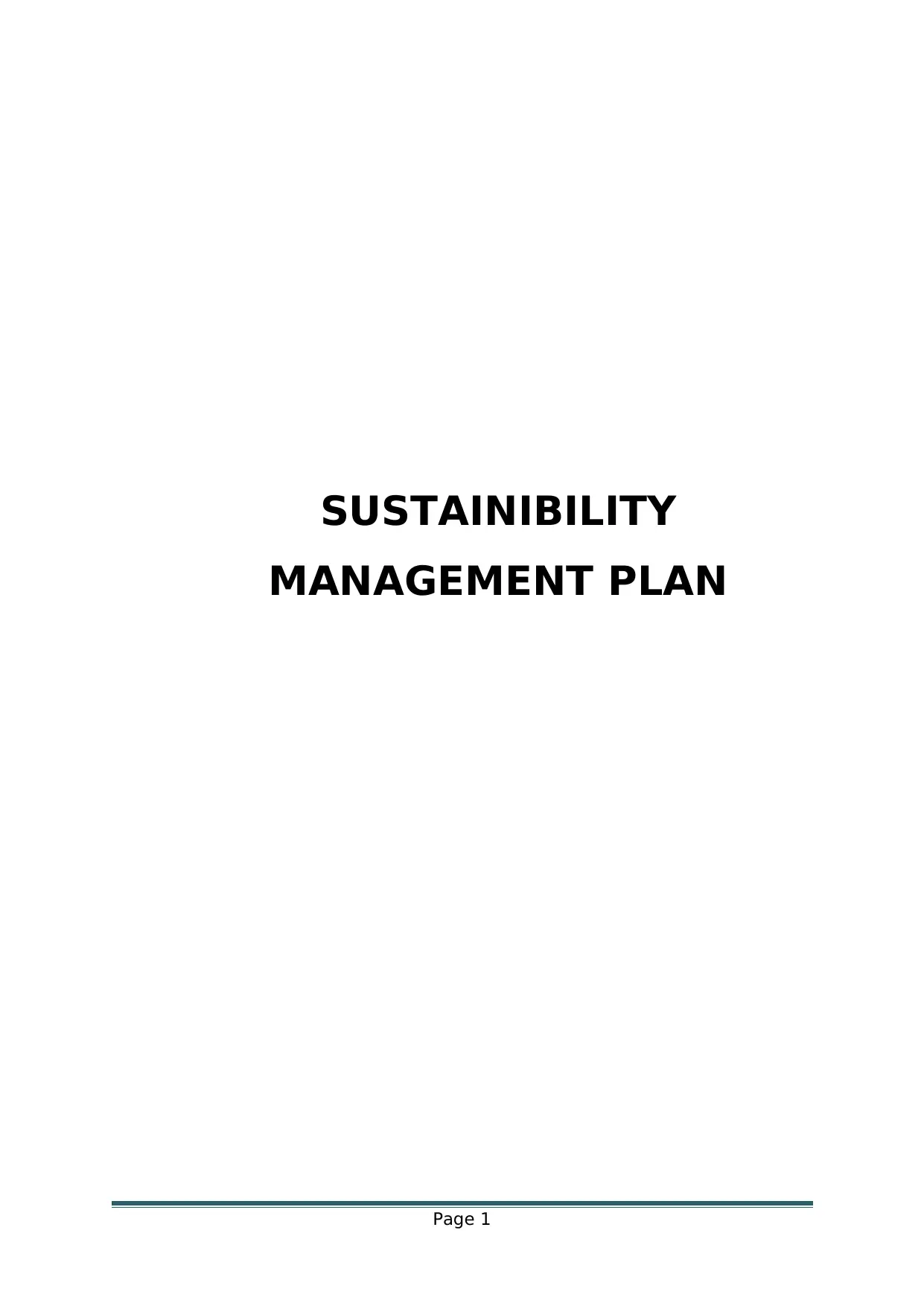
SUSTAINIBILITY
MANAGEMENT PLAN
Page 1
MANAGEMENT PLAN
Page 1
Secure Best Marks with AI Grader
Need help grading? Try our AI Grader for instant feedback on your assignments.
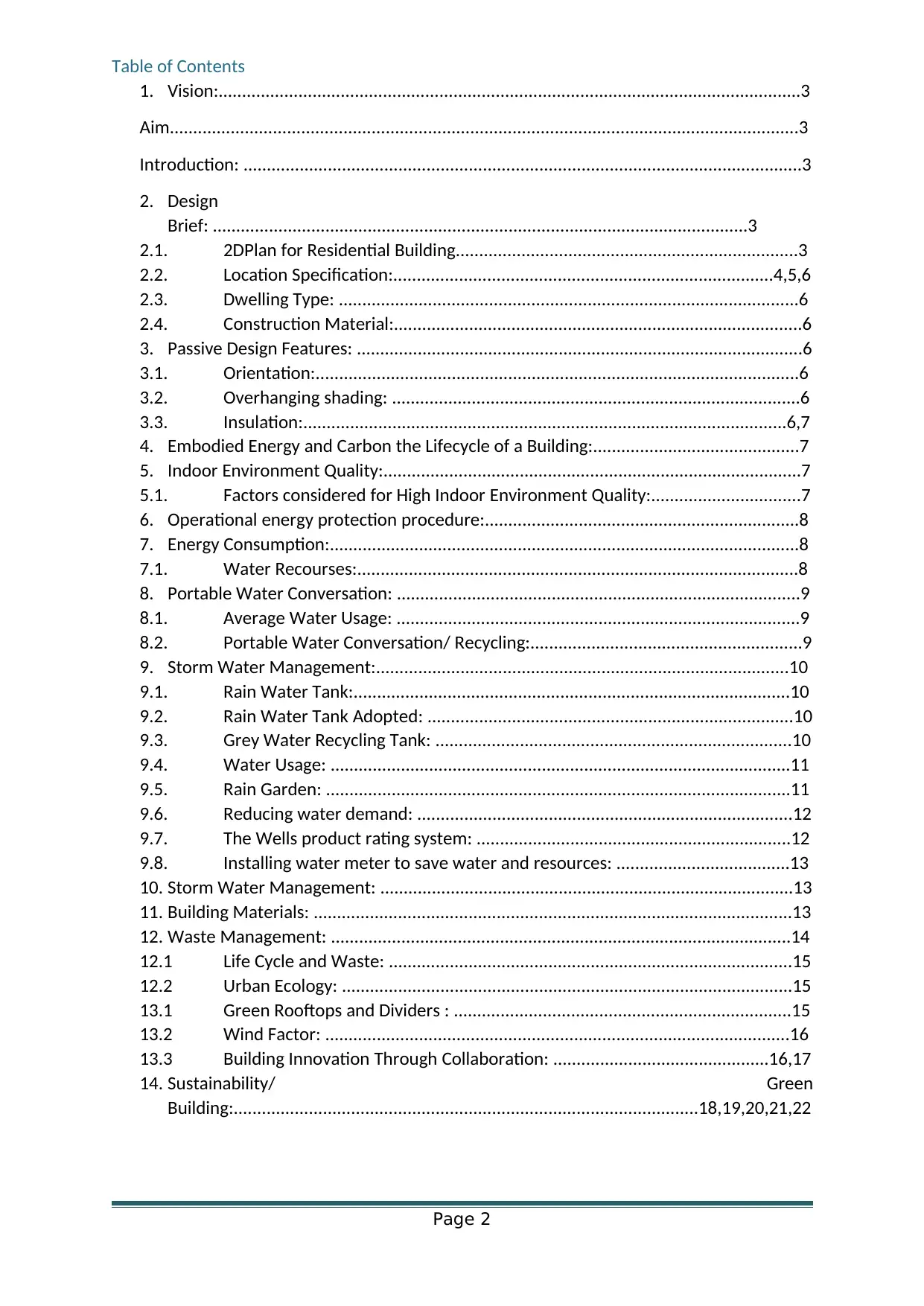
Table of Contents
1. Vision:............................................................................................................................3
Aim......................................................................................................................................3
Introduction: .......................................................................................................................3
2. Design
Brief: ..................................................................................................................3
2.1. 2DPlan for Residential Building.........................................................................3
2.2. Location Specification:.................................................................................4,5,6
2.3. Dwelling Type: ..................................................................................................6
2.4. Construction Material:.......................................................................................6
3. Passive Design Features: ...............................................................................................6
3.1. Orientation:.......................................................................................................6
3.2. Overhanging shading: .......................................................................................6
3.3. Insulation:.......................................................................................................6,7
4. Embodied Energy and Carbon the Lifecycle of a Building:............................................7
5. Indoor Environment Quality:.........................................................................................7
5.1. Factors considered for High Indoor Environment Quality:................................7
6. Operational energy protection procedure:...................................................................8
7. Energy Consumption:....................................................................................................8
7.1. Water Recourses:..............................................................................................8
8. Portable Water Conversation: ......................................................................................9
8.1. Average Water Usage: ......................................................................................9
8.2. Portable Water Conversation/ Recycling:..........................................................9
9. Storm Water Management:........................................................................................10
9.1. Rain Water Tank:.............................................................................................10
9.2. Rain Water Tank Adopted: ..............................................................................10
9.3. Grey Water Recycling Tank: ............................................................................10
9.4. Water Usage: ..................................................................................................11
9.5. Rain Garden: ...................................................................................................11
9.6. Reducing water demand: ................................................................................12
9.7. The Wells product rating system: ...................................................................12
9.8. Installing water meter to save water and resources: .....................................13
10. Storm Water Management: ........................................................................................13
11. Building Materials: ......................................................................................................13
12. Waste Management: ..................................................................................................14
12.1 Life Cycle and Waste: ......................................................................................15
12.2 Urban Ecology: ................................................................................................15
13.1 Green Rooftops and Dividers : ........................................................................15
13.2 Wind Factor: ...................................................................................................16
13.3 Building Innovation Through Collaboration: ..............................................16,17
14. Sustainability/ Green
Building:...................................................................................................18,19,20,21,22
Page 2
1. Vision:............................................................................................................................3
Aim......................................................................................................................................3
Introduction: .......................................................................................................................3
2. Design
Brief: ..................................................................................................................3
2.1. 2DPlan for Residential Building.........................................................................3
2.2. Location Specification:.................................................................................4,5,6
2.3. Dwelling Type: ..................................................................................................6
2.4. Construction Material:.......................................................................................6
3. Passive Design Features: ...............................................................................................6
3.1. Orientation:.......................................................................................................6
3.2. Overhanging shading: .......................................................................................6
3.3. Insulation:.......................................................................................................6,7
4. Embodied Energy and Carbon the Lifecycle of a Building:............................................7
5. Indoor Environment Quality:.........................................................................................7
5.1. Factors considered for High Indoor Environment Quality:................................7
6. Operational energy protection procedure:...................................................................8
7. Energy Consumption:....................................................................................................8
7.1. Water Recourses:..............................................................................................8
8. Portable Water Conversation: ......................................................................................9
8.1. Average Water Usage: ......................................................................................9
8.2. Portable Water Conversation/ Recycling:..........................................................9
9. Storm Water Management:........................................................................................10
9.1. Rain Water Tank:.............................................................................................10
9.2. Rain Water Tank Adopted: ..............................................................................10
9.3. Grey Water Recycling Tank: ............................................................................10
9.4. Water Usage: ..................................................................................................11
9.5. Rain Garden: ...................................................................................................11
9.6. Reducing water demand: ................................................................................12
9.7. The Wells product rating system: ...................................................................12
9.8. Installing water meter to save water and resources: .....................................13
10. Storm Water Management: ........................................................................................13
11. Building Materials: ......................................................................................................13
12. Waste Management: ..................................................................................................14
12.1 Life Cycle and Waste: ......................................................................................15
12.2 Urban Ecology: ................................................................................................15
13.1 Green Rooftops and Dividers : ........................................................................15
13.2 Wind Factor: ...................................................................................................16
13.3 Building Innovation Through Collaboration: ..............................................16,17
14. Sustainability/ Green
Building:...................................................................................................18,19,20,21,22
Page 2
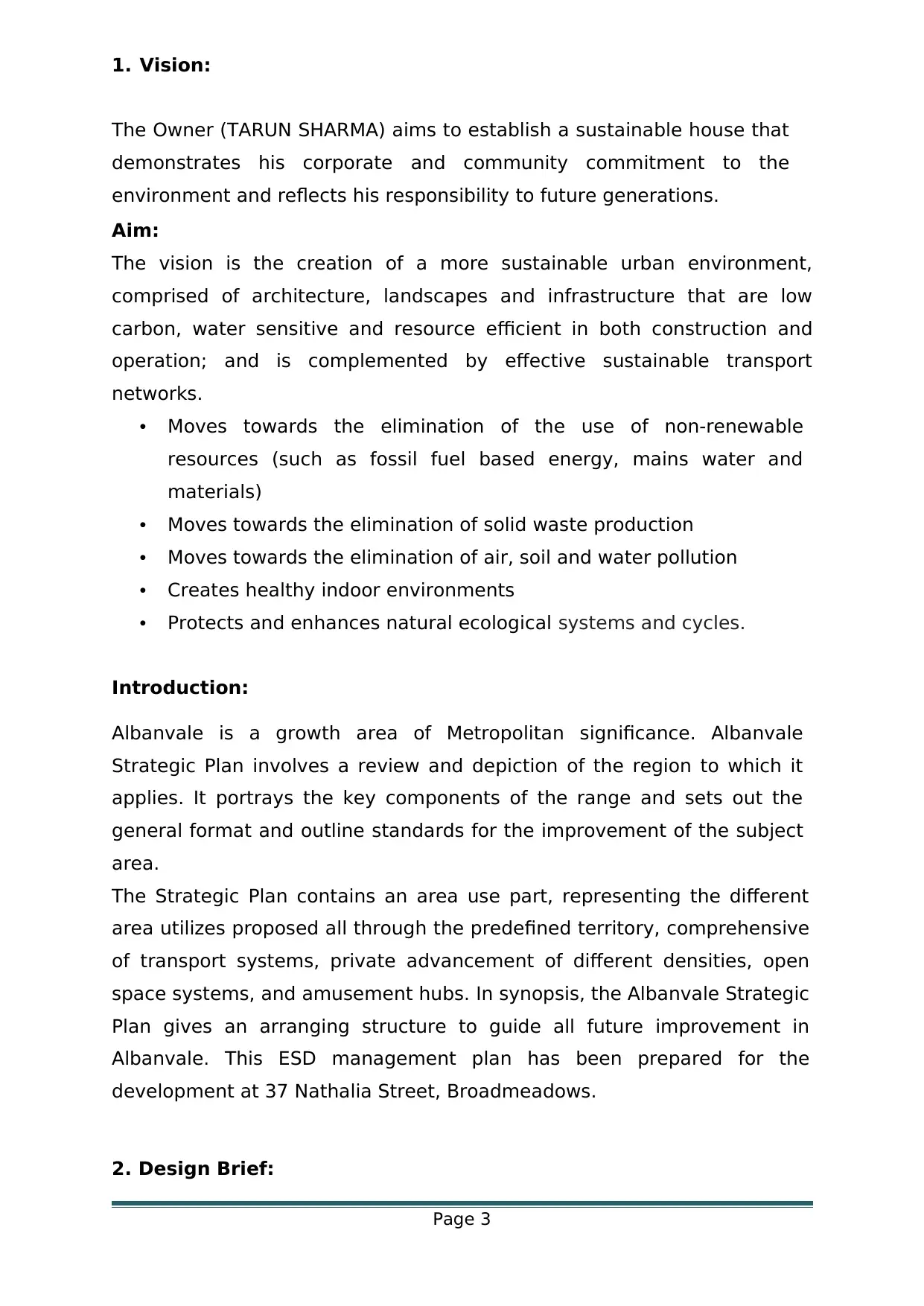
1. Vision:
The Owner (TARUN SHARMA) aims to establish a sustainable house that
demonstrates his corporate and community commitment to the
environment and reflects his responsibility to future generations.
Aim:
The vision is the creation of a more sustainable urban environment,
comprised of architecture, landscapes and infrastructure that are low
carbon, water sensitive and resource efficient in both construction and
operation; and is complemented by effective sustainable transport
networks.
• Moves towards the elimination of the use of non-renewable
resources (such as fossil fuel based energy, mains water and
materials)
• Moves towards the elimination of solid waste production
• Moves towards the elimination of air, soil and water pollution
• Creates healthy indoor environments
• Protects and enhances natural ecological systems and cycles.
Introduction:
Albanvale is a growth area of Metropolitan significance. Albanvale
Strategic Plan involves a review and depiction of the region to which it
applies. It portrays the key components of the range and sets out the
general format and outline standards for the improvement of the subject
area.
The Strategic Plan contains an area use part, representing the different
area utilizes proposed all through the predefined territory, comprehensive
of transport systems, private advancement of different densities, open
space systems, and amusement hubs. In synopsis, the Albanvale Strategic
Plan gives an arranging structure to guide all future improvement in
Albanvale. This ESD management plan has been prepared for the
development at 37 Nathalia Street, Broadmeadows.
2. Design Brief:
Page 3
The Owner (TARUN SHARMA) aims to establish a sustainable house that
demonstrates his corporate and community commitment to the
environment and reflects his responsibility to future generations.
Aim:
The vision is the creation of a more sustainable urban environment,
comprised of architecture, landscapes and infrastructure that are low
carbon, water sensitive and resource efficient in both construction and
operation; and is complemented by effective sustainable transport
networks.
• Moves towards the elimination of the use of non-renewable
resources (such as fossil fuel based energy, mains water and
materials)
• Moves towards the elimination of solid waste production
• Moves towards the elimination of air, soil and water pollution
• Creates healthy indoor environments
• Protects and enhances natural ecological systems and cycles.
Introduction:
Albanvale is a growth area of Metropolitan significance. Albanvale
Strategic Plan involves a review and depiction of the region to which it
applies. It portrays the key components of the range and sets out the
general format and outline standards for the improvement of the subject
area.
The Strategic Plan contains an area use part, representing the different
area utilizes proposed all through the predefined territory, comprehensive
of transport systems, private advancement of different densities, open
space systems, and amusement hubs. In synopsis, the Albanvale Strategic
Plan gives an arranging structure to guide all future improvement in
Albanvale. This ESD management plan has been prepared for the
development at 37 Nathalia Street, Broadmeadows.
2. Design Brief:
Page 3
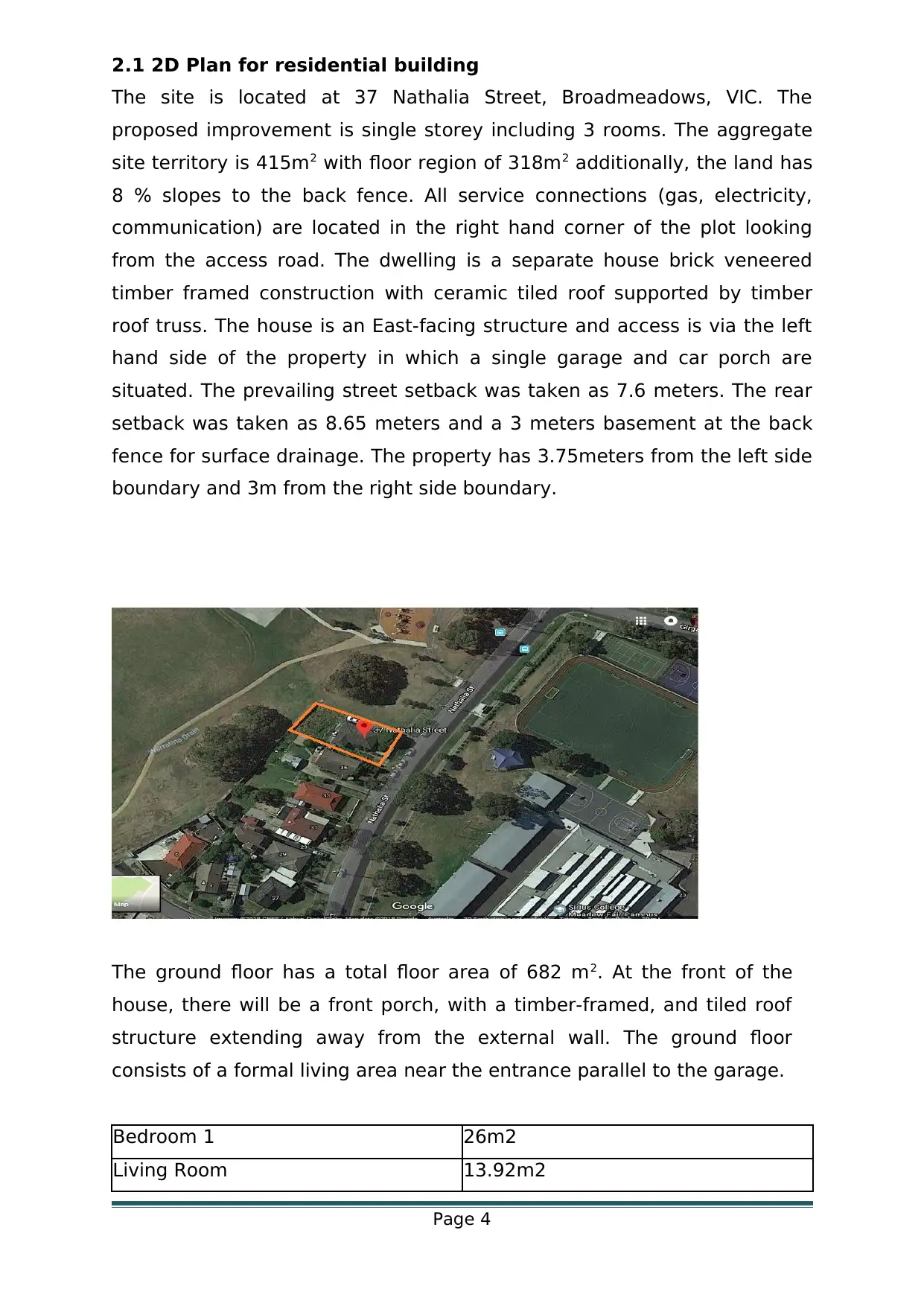
2.1 2D Plan for residential building
The site is located at 37 Nathalia Street, Broadmeadows, VIC. The
proposed improvement is single storey including 3 rooms. The aggregate
site territory is 415m2 with floor region of 318m2 additionally, the land has
8 % slopes to the back fence. All service connections (gas, electricity,
communication) are located in the right hand corner of the plot looking
from the access road. The dwelling is a separate house brick veneered
timber framed construction with ceramic tiled roof supported by timber
roof truss. The house is an East-facing structure and access is via the left
hand side of the property in which a single garage and car porch are
situated. The prevailing street setback was taken as 7.6 meters. The rear
setback was taken as 8.65 meters and a 3 meters basement at the back
fence for surface drainage. The property has 3.75meters from the left side
boundary and 3m from the right side boundary.
The ground floor has a total floor area of 682 m2. At the front of the
house, there will be a front porch, with a timber-framed, and tiled roof
structure extending away from the external wall. The ground floor
consists of a formal living area near the entrance parallel to the garage.
Bedroom 1 26m2
Living Room 13.92m2
Page 4
The site is located at 37 Nathalia Street, Broadmeadows, VIC. The
proposed improvement is single storey including 3 rooms. The aggregate
site territory is 415m2 with floor region of 318m2 additionally, the land has
8 % slopes to the back fence. All service connections (gas, electricity,
communication) are located in the right hand corner of the plot looking
from the access road. The dwelling is a separate house brick veneered
timber framed construction with ceramic tiled roof supported by timber
roof truss. The house is an East-facing structure and access is via the left
hand side of the property in which a single garage and car porch are
situated. The prevailing street setback was taken as 7.6 meters. The rear
setback was taken as 8.65 meters and a 3 meters basement at the back
fence for surface drainage. The property has 3.75meters from the left side
boundary and 3m from the right side boundary.
The ground floor has a total floor area of 682 m2. At the front of the
house, there will be a front porch, with a timber-framed, and tiled roof
structure extending away from the external wall. The ground floor
consists of a formal living area near the entrance parallel to the garage.
Bedroom 1 26m2
Living Room 13.92m2
Page 4
Secure Best Marks with AI Grader
Need help grading? Try our AI Grader for instant feedback on your assignments.
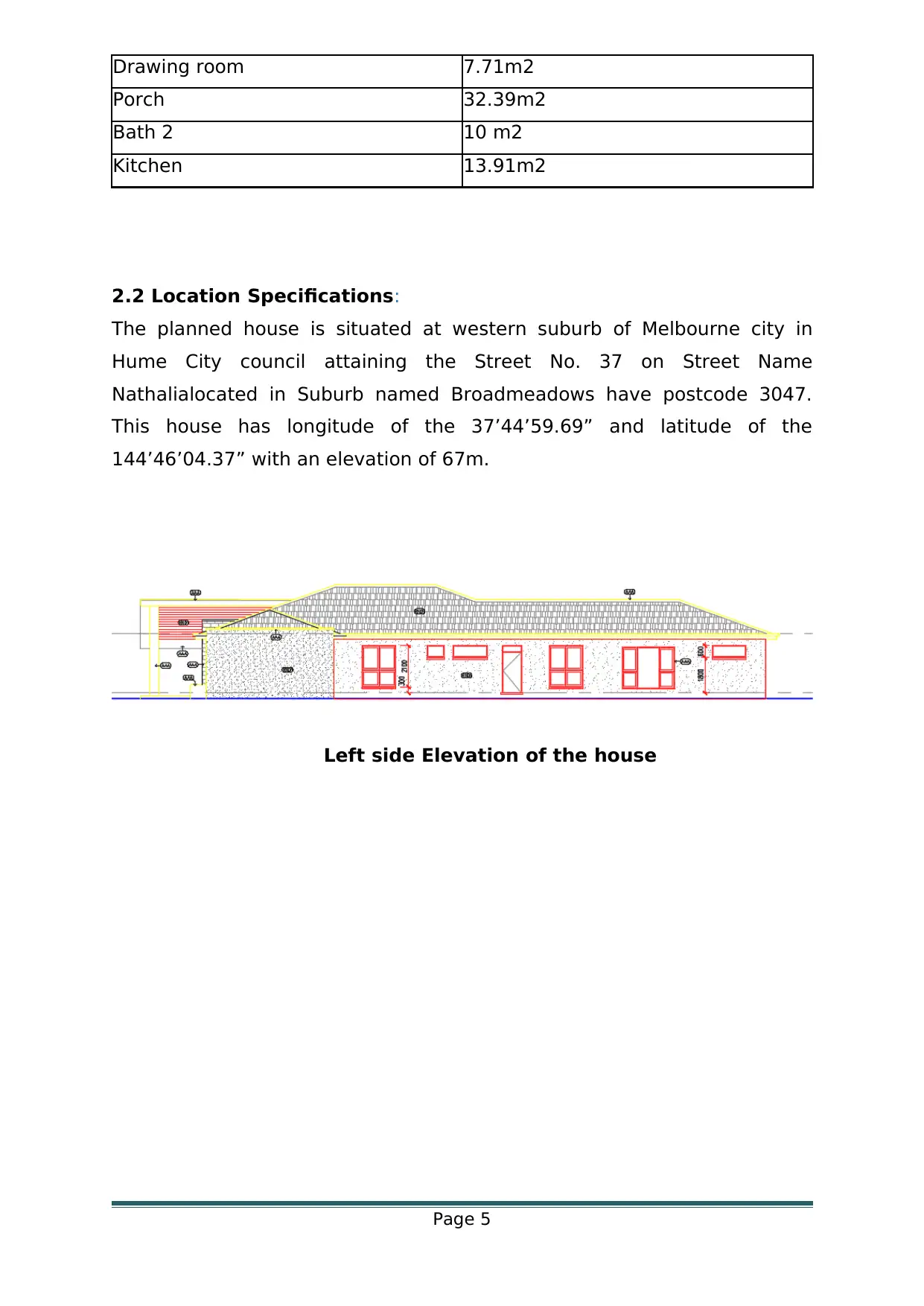
Drawing room 7.71m2
Porch 32.39m2
Bath 2 10 m2
Kitchen 13.91m2
2.2 Location Specifications:
The planned house is situated at western suburb of Melbourne city in
Hume City council attaining the Street No. 37 on Street Name
Nathalialocated in Suburb named Broadmeadows have postcode 3047.
This house has longitude of the 37’44’59.69” and latitude of the
144’46’04.37” with an elevation of 67m.
Left side Elevation of the house
Page 5
Porch 32.39m2
Bath 2 10 m2
Kitchen 13.91m2
2.2 Location Specifications:
The planned house is situated at western suburb of Melbourne city in
Hume City council attaining the Street No. 37 on Street Name
Nathalialocated in Suburb named Broadmeadows have postcode 3047.
This house has longitude of the 37’44’59.69” and latitude of the
144’46’04.37” with an elevation of 67m.
Left side Elevation of the house
Page 5
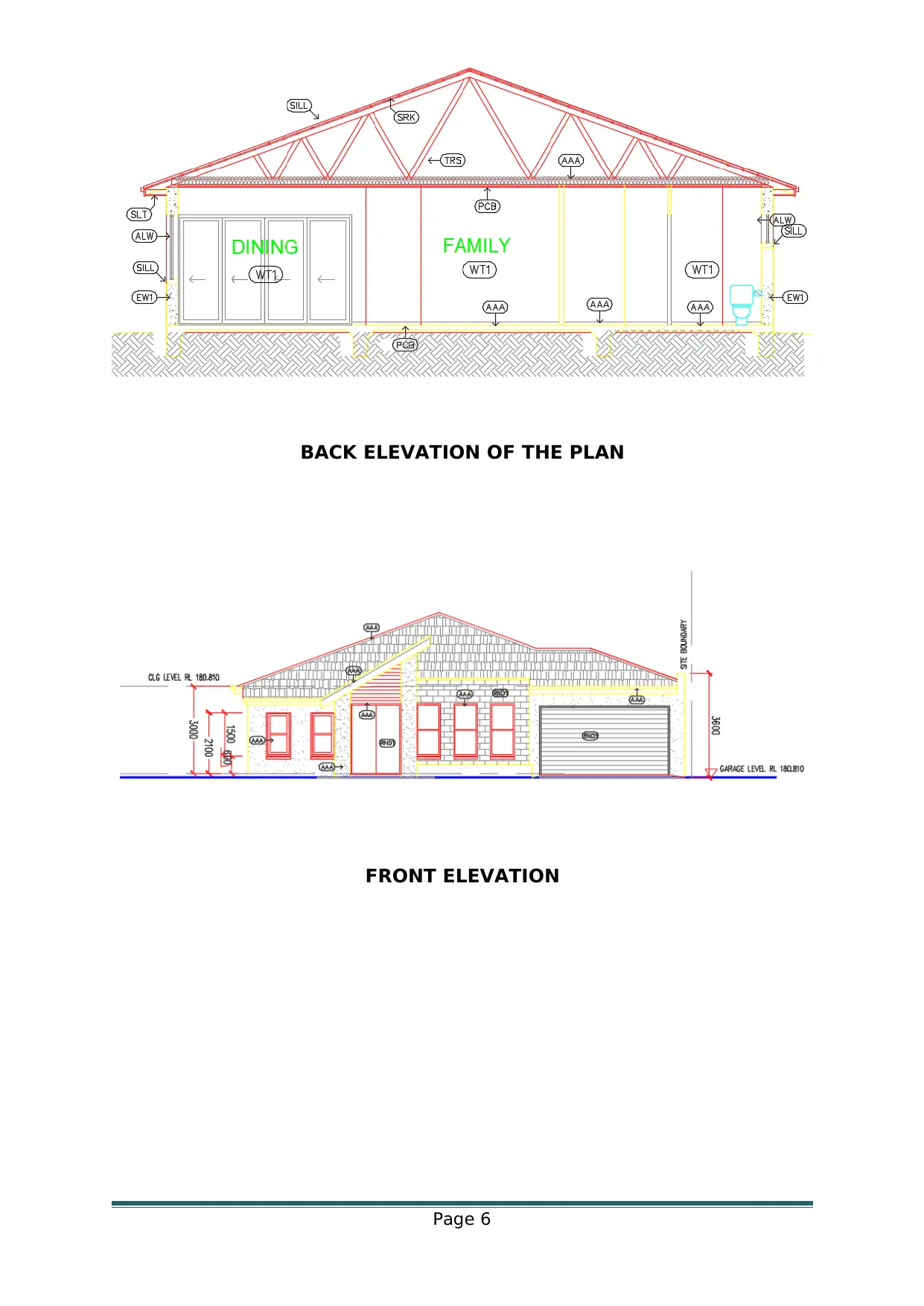
BACK ELEVATION OF THE PLAN
FRONT ELEVATION
Page 6
FRONT ELEVATION
Page 6
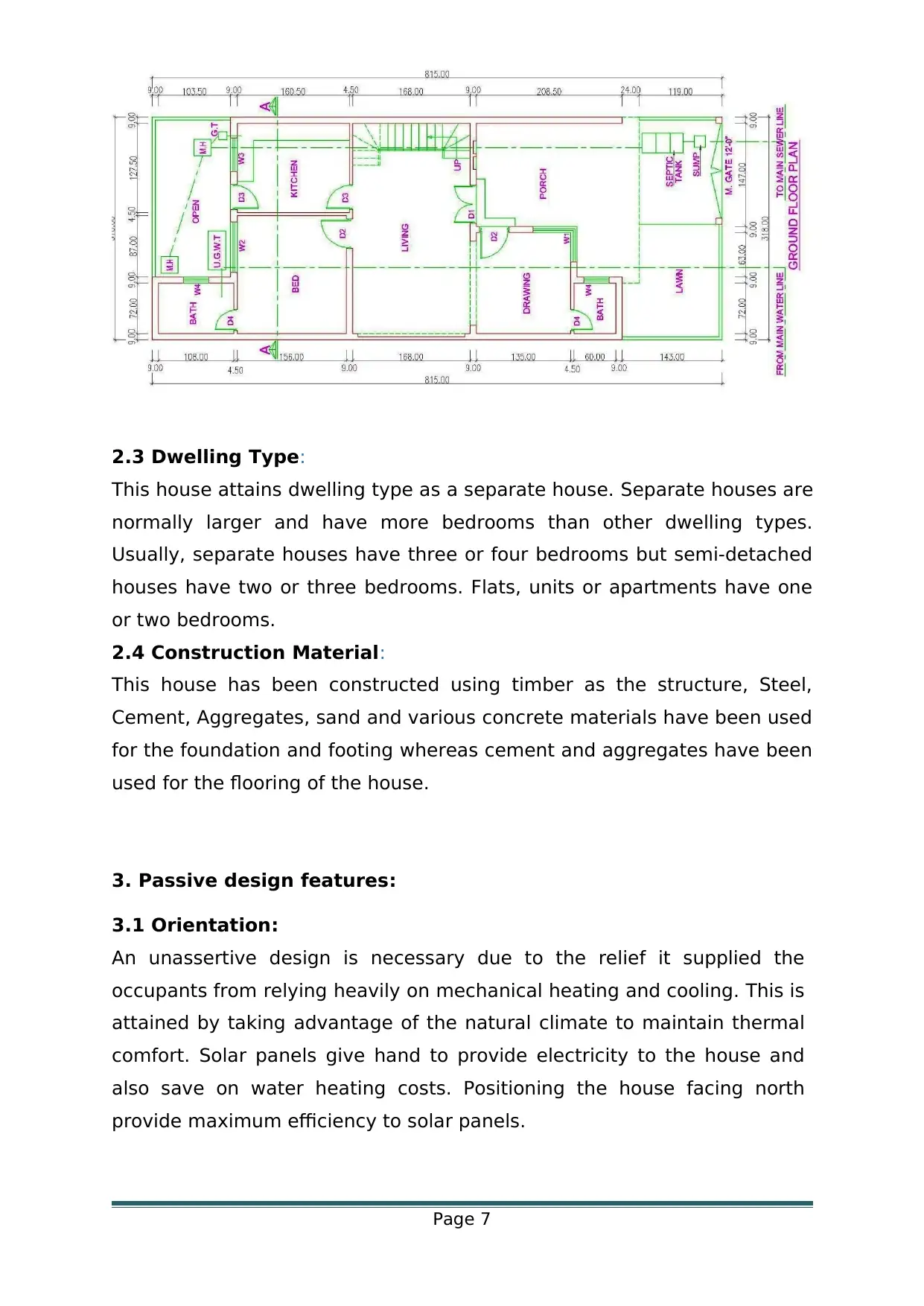
2.3 Dwelling Type:
This house attains dwelling type as a separate house. Separate houses are
normally larger and have more bedrooms than other dwelling types.
Usually, separate houses have three or four bedrooms but semi-detached
houses have two or three bedrooms. Flats, units or apartments have one
or two bedrooms.
2.4 Construction Material:
This house has been constructed using timber as the structure, Steel,
Cement, Aggregates, sand and various concrete materials have been used
for the foundation and footing whereas cement and aggregates have been
used for the flooring of the house.
3. Passive design features:
3.1 Orientation:
An unassertive design is necessary due to the relief it supplied the
occupants from relying heavily on mechanical heating and cooling. This is
attained by taking advantage of the natural climate to maintain thermal
comfort. Solar panels give hand to provide electricity to the house and
also save on water heating costs. Positioning the house facing north
provide maximum efficiency to solar panels.
Page 7
This house attains dwelling type as a separate house. Separate houses are
normally larger and have more bedrooms than other dwelling types.
Usually, separate houses have three or four bedrooms but semi-detached
houses have two or three bedrooms. Flats, units or apartments have one
or two bedrooms.
2.4 Construction Material:
This house has been constructed using timber as the structure, Steel,
Cement, Aggregates, sand and various concrete materials have been used
for the foundation and footing whereas cement and aggregates have been
used for the flooring of the house.
3. Passive design features:
3.1 Orientation:
An unassertive design is necessary due to the relief it supplied the
occupants from relying heavily on mechanical heating and cooling. This is
attained by taking advantage of the natural climate to maintain thermal
comfort. Solar panels give hand to provide electricity to the house and
also save on water heating costs. Positioning the house facing north
provide maximum efficiency to solar panels.
Page 7
Paraphrase This Document
Need a fresh take? Get an instant paraphrase of this document with our AI Paraphraser
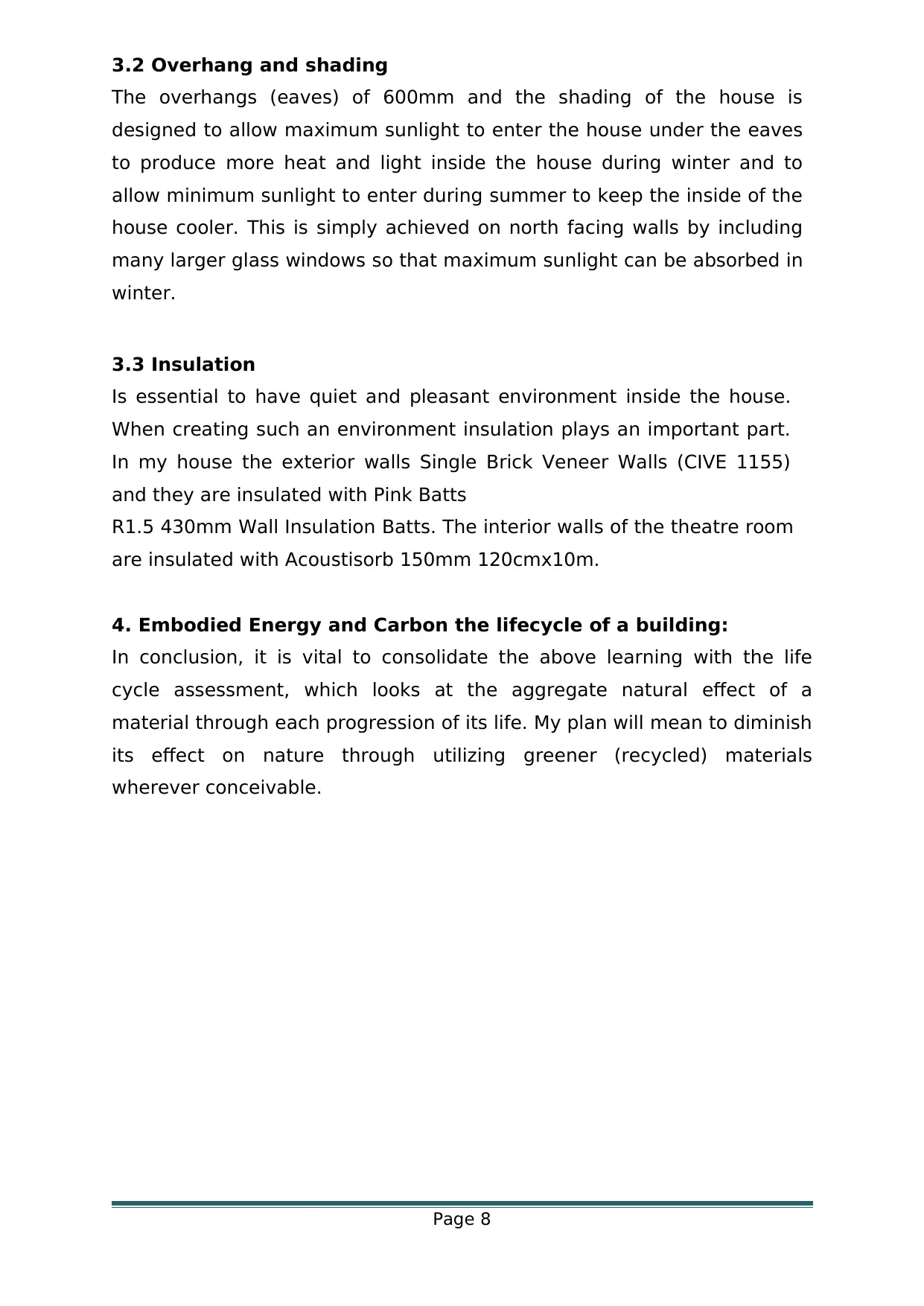
3.2 Overhang and shading
The overhangs (eaves) of 600mm and the shading of the house is
designed to allow maximum sunlight to enter the house under the eaves
to produce more heat and light inside the house during winter and to
allow minimum sunlight to enter during summer to keep the inside of the
house cooler. This is simply achieved on north facing walls by including
many larger glass windows so that maximum sunlight can be absorbed in
winter.
3.3 Insulation
Is essential to have quiet and pleasant environment inside the house.
When creating such an environment insulation plays an important part.
In my house the exterior walls Single Brick Veneer Walls (CIVE 1155)
and they are insulated with Pink Batts
R1.5 430mm Wall Insulation Batts. The interior walls of the theatre room
are insulated with Acoustisorb 150mm 120cmx10m.
4. Embodied Energy and Carbon the lifecycle of a building:
In conclusion, it is vital to consolidate the above learning with the life
cycle assessment, which looks at the aggregate natural effect of a
material through each progression of its life. My plan will mean to diminish
its effect on nature through utilizing greener (recycled) materials
wherever conceivable.
Page 8
The overhangs (eaves) of 600mm and the shading of the house is
designed to allow maximum sunlight to enter the house under the eaves
to produce more heat and light inside the house during winter and to
allow minimum sunlight to enter during summer to keep the inside of the
house cooler. This is simply achieved on north facing walls by including
many larger glass windows so that maximum sunlight can be absorbed in
winter.
3.3 Insulation
Is essential to have quiet and pleasant environment inside the house.
When creating such an environment insulation plays an important part.
In my house the exterior walls Single Brick Veneer Walls (CIVE 1155)
and they are insulated with Pink Batts
R1.5 430mm Wall Insulation Batts. The interior walls of the theatre room
are insulated with Acoustisorb 150mm 120cmx10m.
4. Embodied Energy and Carbon the lifecycle of a building:
In conclusion, it is vital to consolidate the above learning with the life
cycle assessment, which looks at the aggregate natural effect of a
material through each progression of its life. My plan will mean to diminish
its effect on nature through utilizing greener (recycled) materials
wherever conceivable.
Page 8
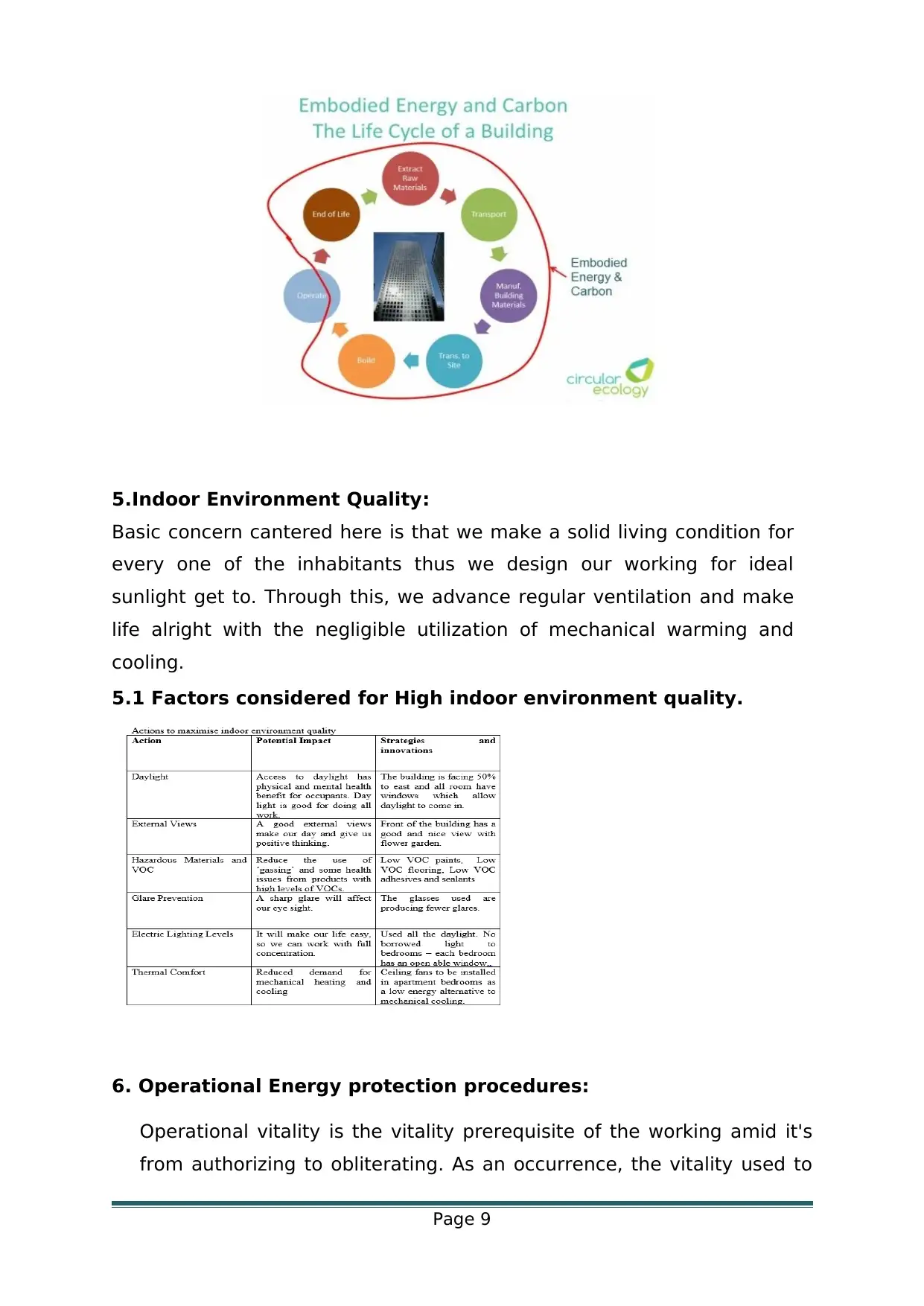
5.Indoor Environment Quality:
Basic concern cantered here is that we make a solid living condition for
every one of the inhabitants thus we design our working for ideal
sunlight get to. Through this, we advance regular ventilation and make
life alright with the negligible utilization of mechanical warming and
cooling.
5.1 Factors considered for High indoor environment quality.
6. Operational Energy protection procedures:
Operational vitality is the vitality prerequisite of the working amid it's
from authorizing to obliterating. As an occurrence, the vitality used to
Page 9
Basic concern cantered here is that we make a solid living condition for
every one of the inhabitants thus we design our working for ideal
sunlight get to. Through this, we advance regular ventilation and make
life alright with the negligible utilization of mechanical warming and
cooling.
5.1 Factors considered for High indoor environment quality.
6. Operational Energy protection procedures:
Operational vitality is the vitality prerequisite of the working amid it's
from authorizing to obliterating. As an occurrence, the vitality used to
Page 9
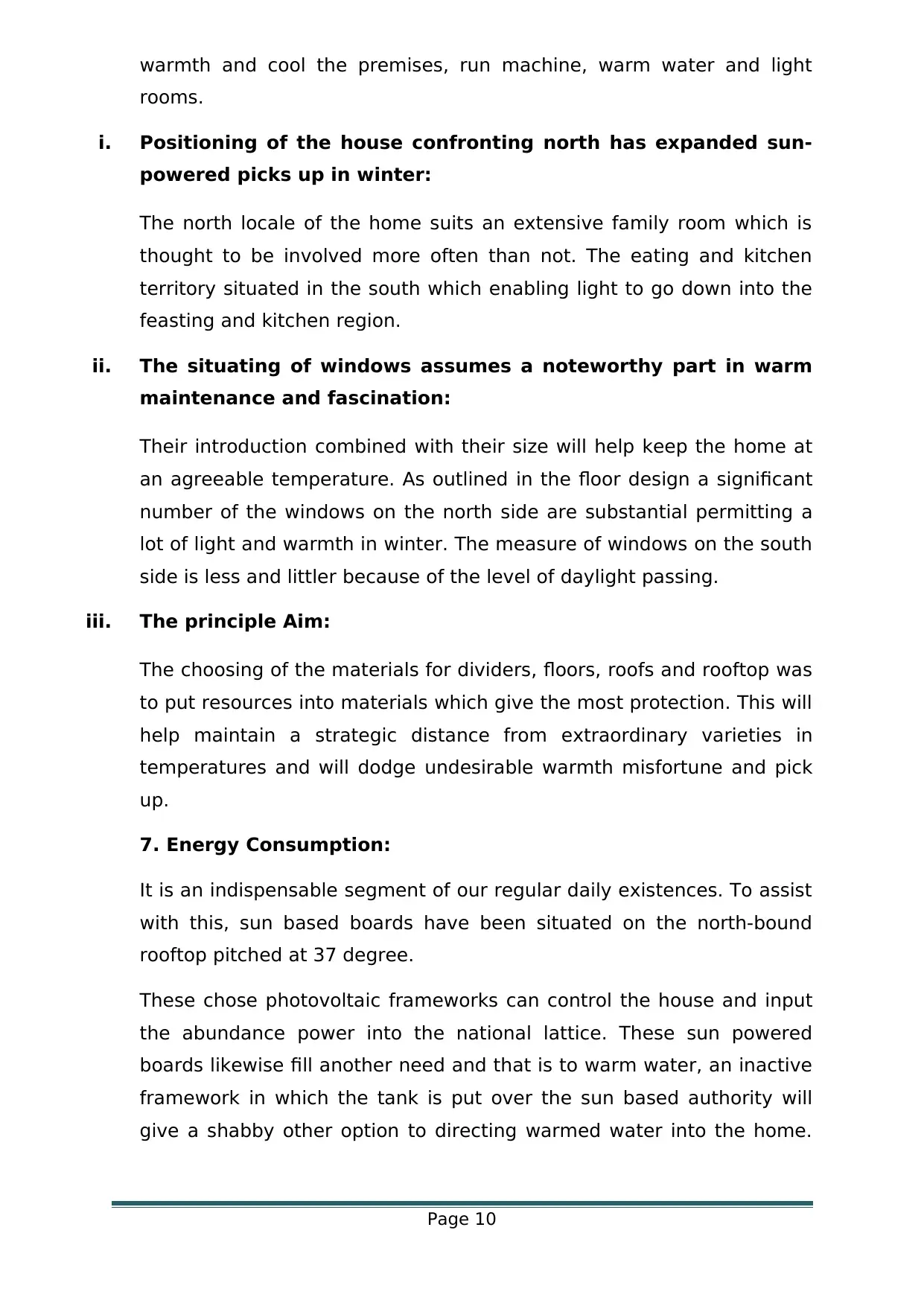
warmth and cool the premises, run machine, warm water and light
rooms.
i. Positioning of the house confronting north has expanded sun-
powered picks up in winter:
The north locale of the home suits an extensive family room which is
thought to be involved more often than not. The eating and kitchen
territory situated in the south which enabling light to go down into the
feasting and kitchen region.
ii. The situating of windows assumes a noteworthy part in warm
maintenance and fascination:
Their introduction combined with their size will help keep the home at
an agreeable temperature. As outlined in the floor design a significant
number of the windows on the north side are substantial permitting a
lot of light and warmth in winter. The measure of windows on the south
side is less and littler because of the level of daylight passing.
iii. The principle Aim:
The choosing of the materials for dividers, floors, roofs and rooftop was
to put resources into materials which give the most protection. This will
help maintain a strategic distance from extraordinary varieties in
temperatures and will dodge undesirable warmth misfortune and pick
up.
7. Energy Consumption:
It is an indispensable segment of our regular daily existences. To assist
with this, sun based boards have been situated on the north-bound
rooftop pitched at 37 degree.
These chose photovoltaic frameworks can control the house and input
the abundance power into the national lattice. These sun powered
boards likewise fill another need and that is to warm water, an inactive
framework in which the tank is put over the sun based authority will
give a shabby other option to directing warmed water into the home.
Page 10
rooms.
i. Positioning of the house confronting north has expanded sun-
powered picks up in winter:
The north locale of the home suits an extensive family room which is
thought to be involved more often than not. The eating and kitchen
territory situated in the south which enabling light to go down into the
feasting and kitchen region.
ii. The situating of windows assumes a noteworthy part in warm
maintenance and fascination:
Their introduction combined with their size will help keep the home at
an agreeable temperature. As outlined in the floor design a significant
number of the windows on the north side are substantial permitting a
lot of light and warmth in winter. The measure of windows on the south
side is less and littler because of the level of daylight passing.
iii. The principle Aim:
The choosing of the materials for dividers, floors, roofs and rooftop was
to put resources into materials which give the most protection. This will
help maintain a strategic distance from extraordinary varieties in
temperatures and will dodge undesirable warmth misfortune and pick
up.
7. Energy Consumption:
It is an indispensable segment of our regular daily existences. To assist
with this, sun based boards have been situated on the north-bound
rooftop pitched at 37 degree.
These chose photovoltaic frameworks can control the house and input
the abundance power into the national lattice. These sun powered
boards likewise fill another need and that is to warm water, an inactive
framework in which the tank is put over the sun based authority will
give a shabby other option to directing warmed water into the home.
Page 10
Secure Best Marks with AI Grader
Need help grading? Try our AI Grader for instant feedback on your assignments.
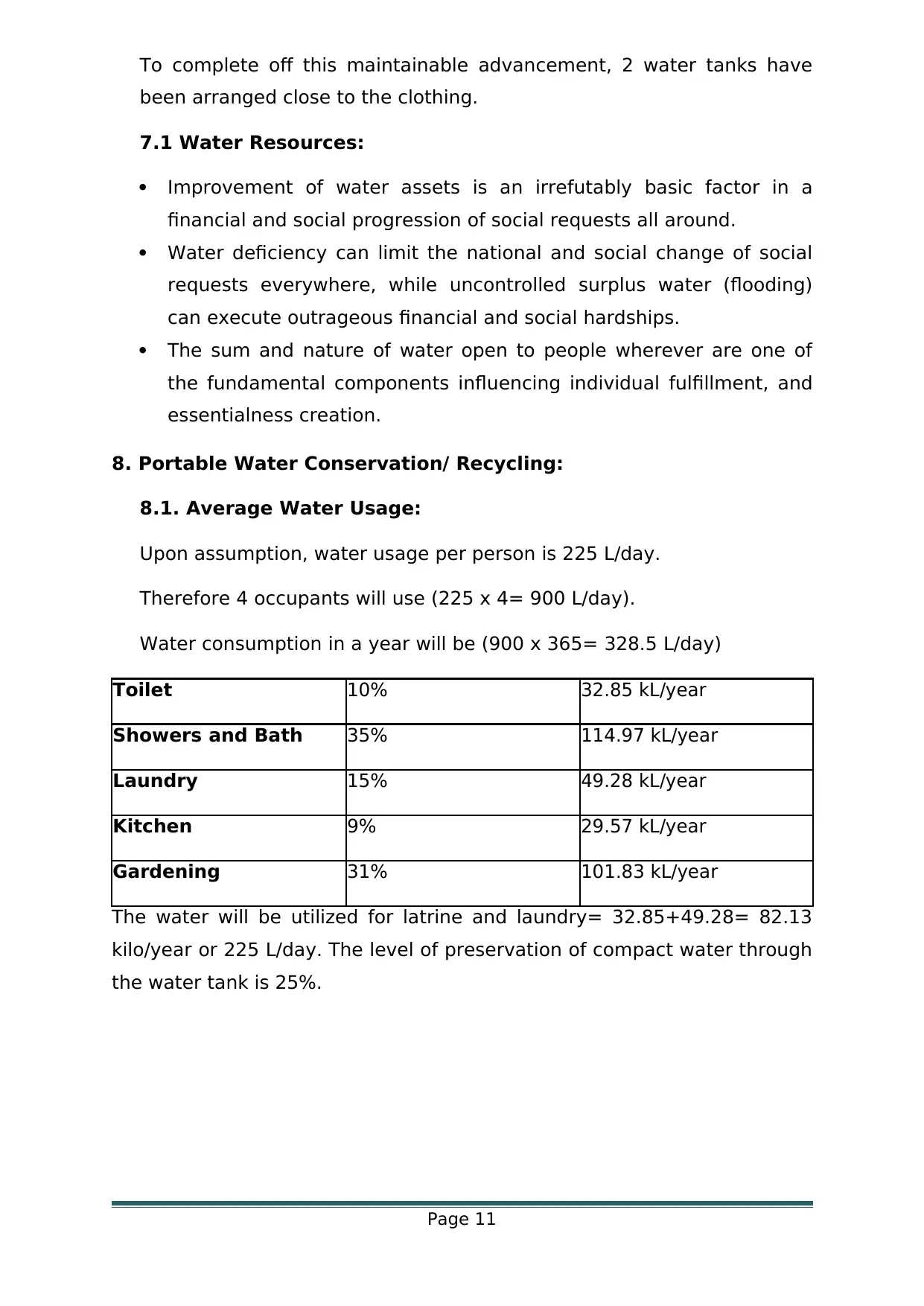
To complete off this maintainable advancement, 2 water tanks have
been arranged close to the clothing.
7.1 Water Resources:
Improvement of water assets is an irrefutably basic factor in a
financial and social progression of social requests all around.
Water deficiency can limit the national and social change of social
requests everywhere, while uncontrolled surplus water (flooding)
can execute outrageous financial and social hardships.
The sum and nature of water open to people wherever are one of
the fundamental components influencing individual fulfillment, and
essentialness creation.
8. Portable Water Conservation/ Recycling:
8.1. Average Water Usage:
Upon assumption, water usage per person is 225 L/day.
Therefore 4 occupants will use (225 x 4= 900 L/day).
Water consumption in a year will be (900 x 365= 328.5 L/day)
Toilet 10% 32.85 kL/year
Showers and Bath 35% 114.97 kL/year
Laundry 15% 49.28 kL/year
Kitchen 9% 29.57 kL/year
Gardening 31% 101.83 kL/year
The water will be utilized for latrine and laundry= 32.85+49.28= 82.13
kilo/year or 225 L/day. The level of preservation of compact water through
the water tank is 25%.
Page 11
been arranged close to the clothing.
7.1 Water Resources:
Improvement of water assets is an irrefutably basic factor in a
financial and social progression of social requests all around.
Water deficiency can limit the national and social change of social
requests everywhere, while uncontrolled surplus water (flooding)
can execute outrageous financial and social hardships.
The sum and nature of water open to people wherever are one of
the fundamental components influencing individual fulfillment, and
essentialness creation.
8. Portable Water Conservation/ Recycling:
8.1. Average Water Usage:
Upon assumption, water usage per person is 225 L/day.
Therefore 4 occupants will use (225 x 4= 900 L/day).
Water consumption in a year will be (900 x 365= 328.5 L/day)
Toilet 10% 32.85 kL/year
Showers and Bath 35% 114.97 kL/year
Laundry 15% 49.28 kL/year
Kitchen 9% 29.57 kL/year
Gardening 31% 101.83 kL/year
The water will be utilized for latrine and laundry= 32.85+49.28= 82.13
kilo/year or 225 L/day. The level of preservation of compact water through
the water tank is 25%.
Page 11
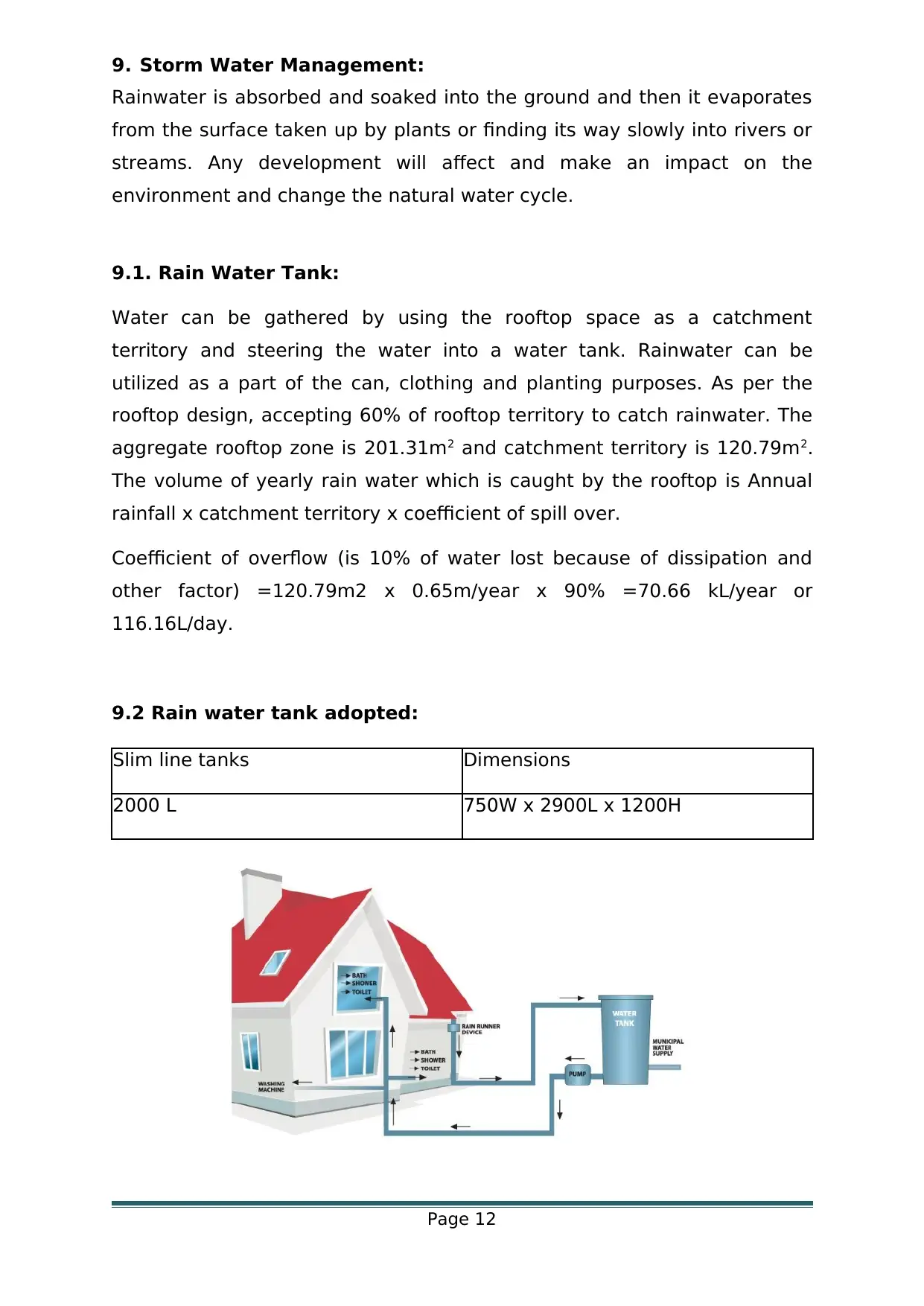
9. Storm Water Management:
Rainwater is absorbed and soaked into the ground and then it evaporates
from the surface taken up by plants or finding its way slowly into rivers or
streams. Any development will affect and make an impact on the
environment and change the natural water cycle.
9.1. Rain Water Tank:
Water can be gathered by using the rooftop space as a catchment
territory and steering the water into a water tank. Rainwater can be
utilized as a part of the can, clothing and planting purposes. As per the
rooftop design, accepting 60% of rooftop territory to catch rainwater. The
aggregate rooftop zone is 201.31m2 and catchment territory is 120.79m2.
The volume of yearly rain water which is caught by the rooftop is Annual
rainfall x catchment territory x coefficient of spill over.
Coefficient of overflow (is 10% of water lost because of dissipation and
other factor) =120.79m2 x 0.65m/year x 90% =70.66 kL/year or
116.16L/day.
9.2 Rain water tank adopted:
Slim line tanks Dimensions
2000 L 750W x 2900L x 1200H
Page 12
Rainwater is absorbed and soaked into the ground and then it evaporates
from the surface taken up by plants or finding its way slowly into rivers or
streams. Any development will affect and make an impact on the
environment and change the natural water cycle.
9.1. Rain Water Tank:
Water can be gathered by using the rooftop space as a catchment
territory and steering the water into a water tank. Rainwater can be
utilized as a part of the can, clothing and planting purposes. As per the
rooftop design, accepting 60% of rooftop territory to catch rainwater. The
aggregate rooftop zone is 201.31m2 and catchment territory is 120.79m2.
The volume of yearly rain water which is caught by the rooftop is Annual
rainfall x catchment territory x coefficient of spill over.
Coefficient of overflow (is 10% of water lost because of dissipation and
other factor) =120.79m2 x 0.65m/year x 90% =70.66 kL/year or
116.16L/day.
9.2 Rain water tank adopted:
Slim line tanks Dimensions
2000 L 750W x 2900L x 1200H
Page 12
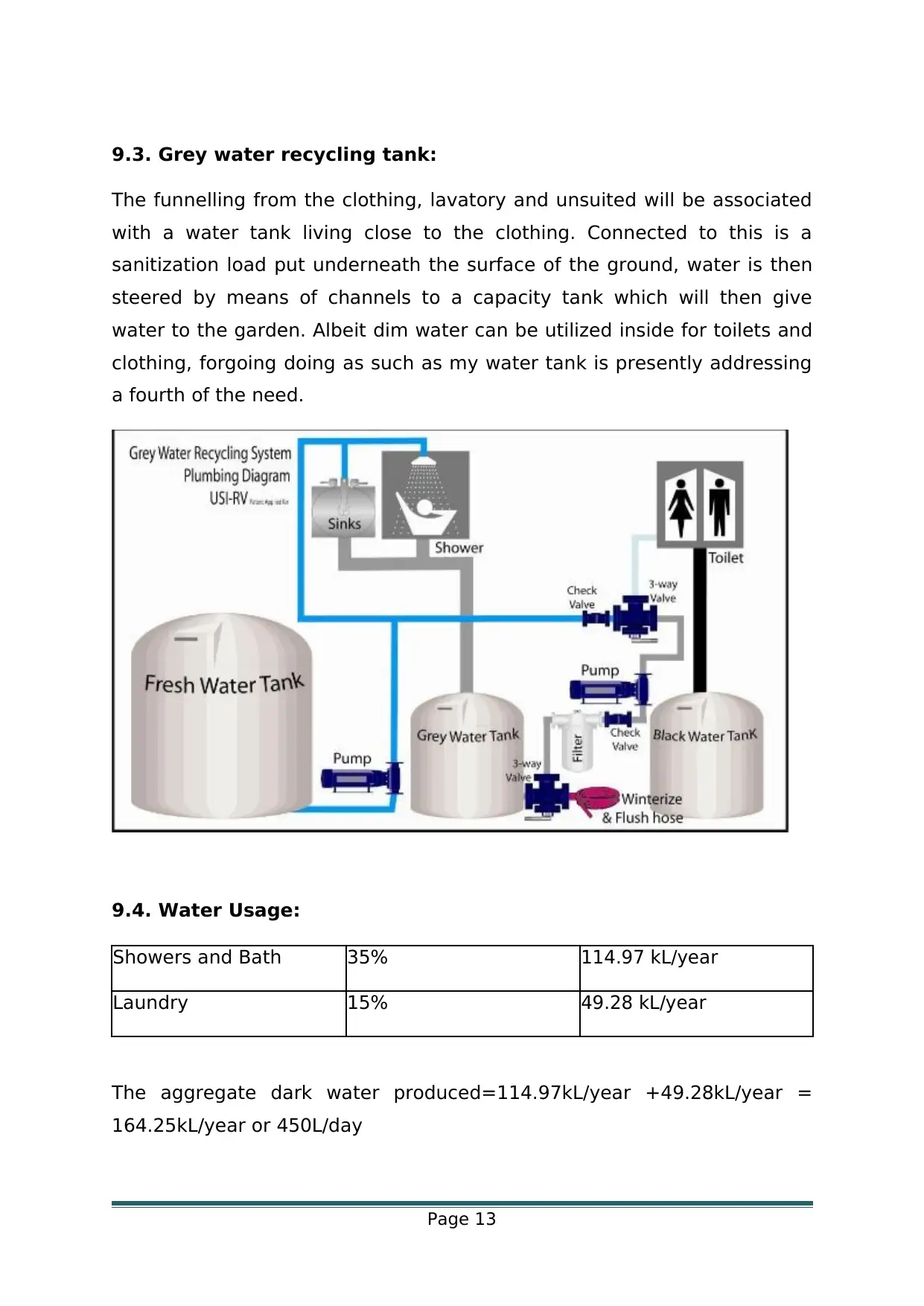
9.3. Grey water recycling tank:
The funnelling from the clothing, lavatory and unsuited will be associated
with a water tank living close to the clothing. Connected to this is a
sanitization load put underneath the surface of the ground, water is then
steered by means of channels to a capacity tank which will then give
water to the garden. Albeit dim water can be utilized inside for toilets and
clothing, forgoing doing as such as my water tank is presently addressing
a fourth of the need.
9.4. Water Usage:
Showers and Bath 35% 114.97 kL/year
Laundry 15% 49.28 kL/year
The aggregate dark water produced=114.97kL/year +49.28kL/year =
164.25kL/year or 450L/day
Page 13
The funnelling from the clothing, lavatory and unsuited will be associated
with a water tank living close to the clothing. Connected to this is a
sanitization load put underneath the surface of the ground, water is then
steered by means of channels to a capacity tank which will then give
water to the garden. Albeit dim water can be utilized inside for toilets and
clothing, forgoing doing as such as my water tank is presently addressing
a fourth of the need.
9.4. Water Usage:
Showers and Bath 35% 114.97 kL/year
Laundry 15% 49.28 kL/year
The aggregate dark water produced=114.97kL/year +49.28kL/year =
164.25kL/year or 450L/day
Page 13
Paraphrase This Document
Need a fresh take? Get an instant paraphrase of this document with our AI Paraphraser
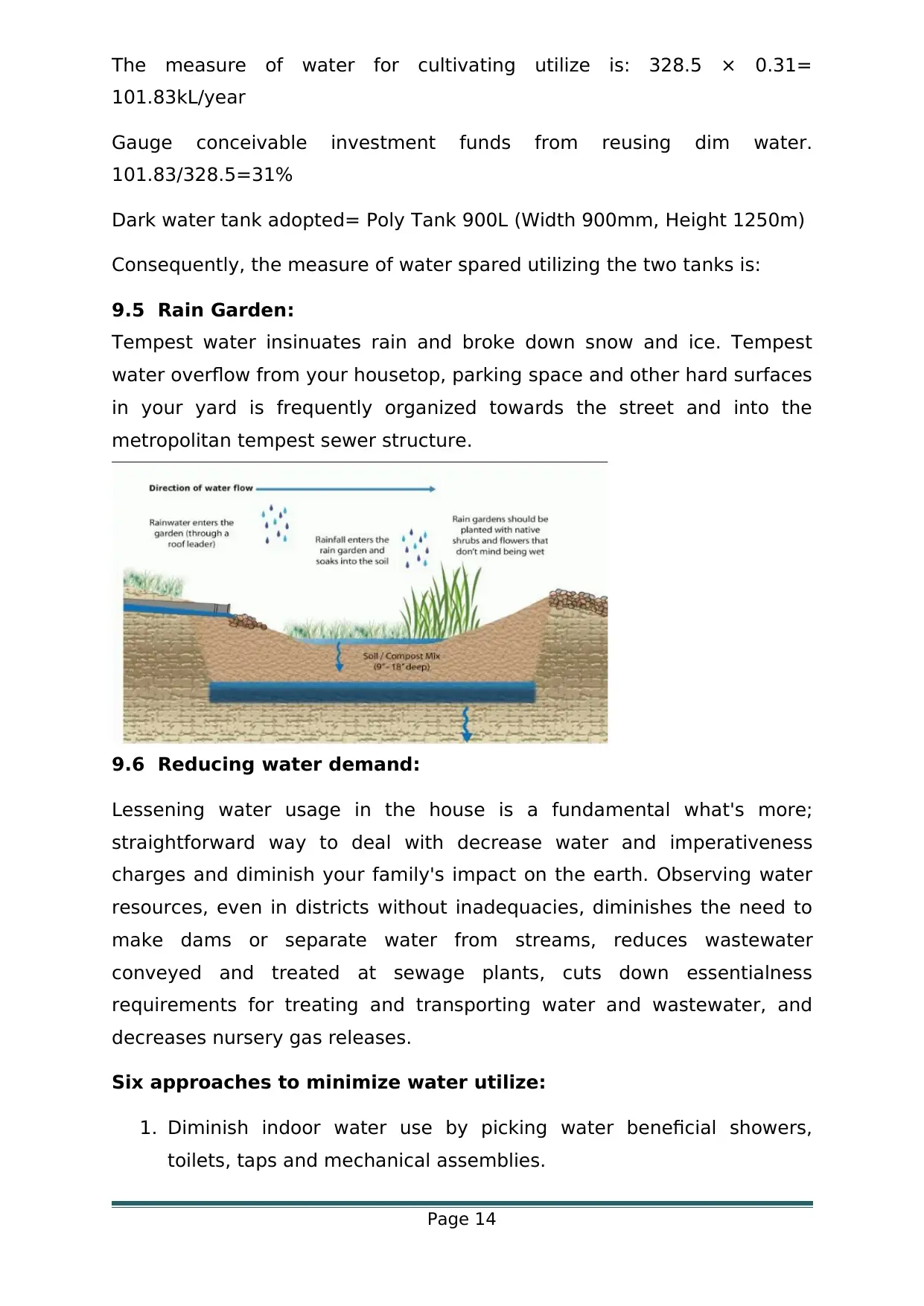
The measure of water for cultivating utilize is: 328.5 × 0.31=
101.83kL/year
Gauge conceivable investment funds from reusing dim water.
101.83/328.5=31%
Dark water tank adopted= Poly Tank 900L (Width 900mm, Height 1250m)
Consequently, the measure of water spared utilizing the two tanks is:
9.5 Rain Garden:
Tempest water insinuates rain and broke down snow and ice. Tempest
water overflow from your housetop, parking space and other hard surfaces
in your yard is frequently organized towards the street and into the
metropolitan tempest sewer structure.
9.6 Reducing water demand:
Lessening water usage in the house is a fundamental what's more;
straightforward way to deal with decrease water and imperativeness
charges and diminish your family's impact on the earth. Observing water
resources, even in districts without inadequacies, diminishes the need to
make dams or separate water from streams, reduces wastewater
conveyed and treated at sewage plants, cuts down essentialness
requirements for treating and transporting water and wastewater, and
decreases nursery gas releases.
Six approaches to minimize water utilize:
1. Diminish indoor water use by picking water beneficial showers,
toilets, taps and mechanical assemblies.
Page 14
101.83kL/year
Gauge conceivable investment funds from reusing dim water.
101.83/328.5=31%
Dark water tank adopted= Poly Tank 900L (Width 900mm, Height 1250m)
Consequently, the measure of water spared utilizing the two tanks is:
9.5 Rain Garden:
Tempest water insinuates rain and broke down snow and ice. Tempest
water overflow from your housetop, parking space and other hard surfaces
in your yard is frequently organized towards the street and into the
metropolitan tempest sewer structure.
9.6 Reducing water demand:
Lessening water usage in the house is a fundamental what's more;
straightforward way to deal with decrease water and imperativeness
charges and diminish your family's impact on the earth. Observing water
resources, even in districts without inadequacies, diminishes the need to
make dams or separate water from streams, reduces wastewater
conveyed and treated at sewage plants, cuts down essentialness
requirements for treating and transporting water and wastewater, and
decreases nursery gas releases.
Six approaches to minimize water utilize:
1. Diminish indoor water use by picking water beneficial showers,
toilets, taps and mechanical assemblies.
Page 14
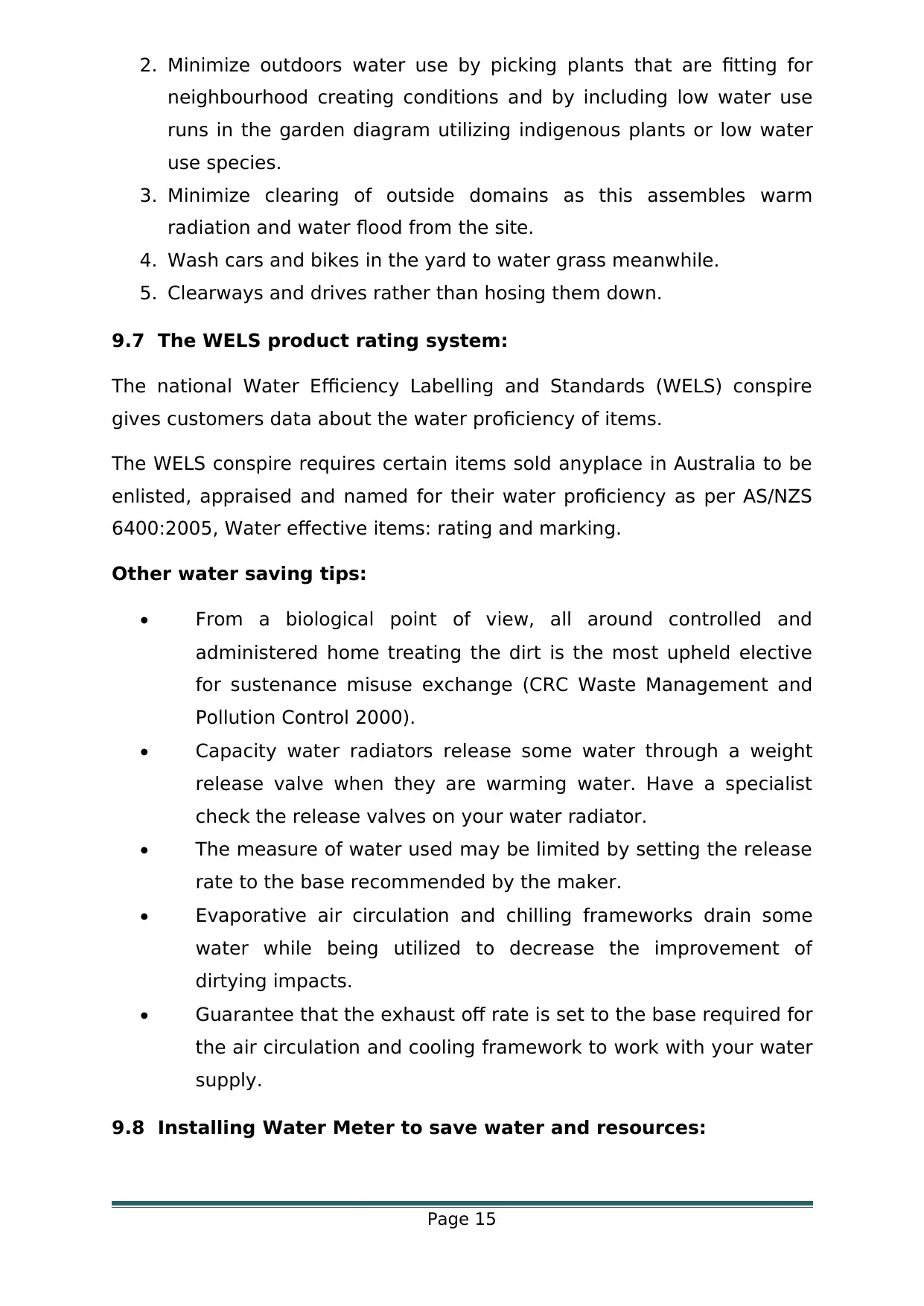
2. Minimize outdoors water use by picking plants that are fitting for
neighbourhood creating conditions and by including low water use
runs in the garden diagram utilizing indigenous plants or low water
use species.
3. Minimize clearing of outside domains as this assembles warm
radiation and water flood from the site.
4. Wash cars and bikes in the yard to water grass meanwhile.
5. Clearways and drives rather than hosing them down.
9.7 The WELS product rating system:
The national Water Efficiency Labelling and Standards (WELS) conspire
gives customers data about the water proficiency of items.
The WELS conspire requires certain items sold anyplace in Australia to be
enlisted, appraised and named for their water proficiency as per AS/NZS
6400:2005, Water effective items: rating and marking.
Other water saving tips:
• From a biological point of view, all around controlled and
administered home treating the dirt is the most upheld elective
for sustenance misuse exchange (CRC Waste Management and
Pollution Control 2000).
• Capacity water radiators release some water through a weight
release valve when they are warming water. Have a specialist
check the release valves on your water radiator.
• The measure of water used may be limited by setting the release
rate to the base recommended by the maker.
• Evaporative air circulation and chilling frameworks drain some
water while being utilized to decrease the improvement of
dirtying impacts.
• Guarantee that the exhaust off rate is set to the base required for
the air circulation and cooling framework to work with your water
supply.
9.8 Installing Water Meter to save water and resources:
Page 15
neighbourhood creating conditions and by including low water use
runs in the garden diagram utilizing indigenous plants or low water
use species.
3. Minimize clearing of outside domains as this assembles warm
radiation and water flood from the site.
4. Wash cars and bikes in the yard to water grass meanwhile.
5. Clearways and drives rather than hosing them down.
9.7 The WELS product rating system:
The national Water Efficiency Labelling and Standards (WELS) conspire
gives customers data about the water proficiency of items.
The WELS conspire requires certain items sold anyplace in Australia to be
enlisted, appraised and named for their water proficiency as per AS/NZS
6400:2005, Water effective items: rating and marking.
Other water saving tips:
• From a biological point of view, all around controlled and
administered home treating the dirt is the most upheld elective
for sustenance misuse exchange (CRC Waste Management and
Pollution Control 2000).
• Capacity water radiators release some water through a weight
release valve when they are warming water. Have a specialist
check the release valves on your water radiator.
• The measure of water used may be limited by setting the release
rate to the base recommended by the maker.
• Evaporative air circulation and chilling frameworks drain some
water while being utilized to decrease the improvement of
dirtying impacts.
• Guarantee that the exhaust off rate is set to the base required for
the air circulation and cooling framework to work with your water
supply.
9.8 Installing Water Meter to save water and resources:
Page 15
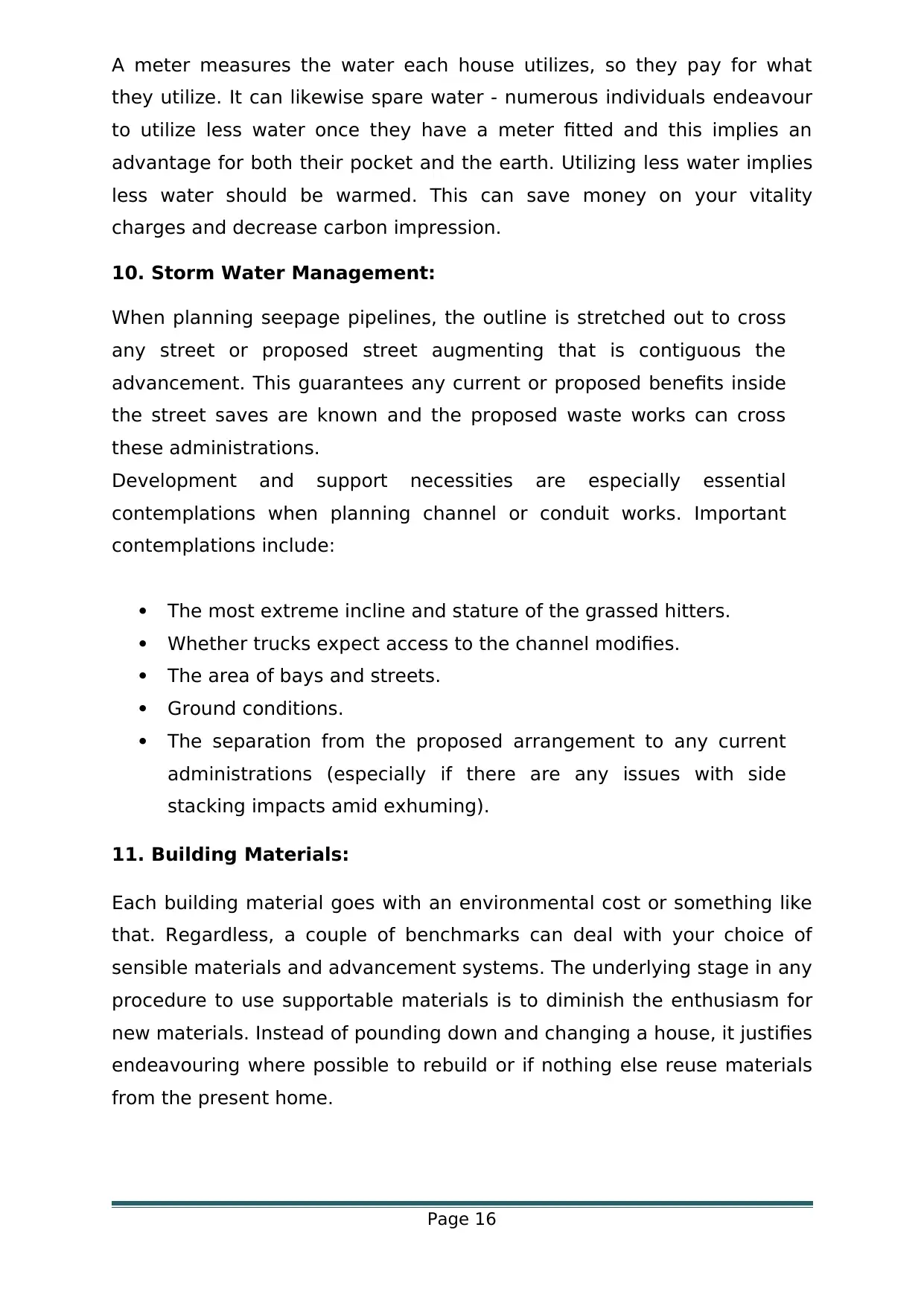
A meter measures the water each house utilizes, so they pay for what
they utilize. It can likewise spare water - numerous individuals endeavour
to utilize less water once they have a meter fitted and this implies an
advantage for both their pocket and the earth. Utilizing less water implies
less water should be warmed. This can save money on your vitality
charges and decrease carbon impression.
10. Storm Water Management:
When planning seepage pipelines, the outline is stretched out to cross
any street or proposed street augmenting that is contiguous the
advancement. This guarantees any current or proposed benefits inside
the street saves are known and the proposed waste works can cross
these administrations.
Development and support necessities are especially essential
contemplations when planning channel or conduit works. Important
contemplations include:
The most extreme incline and stature of the grassed hitters.
Whether trucks expect access to the channel modifies.
The area of bays and streets.
Ground conditions.
The separation from the proposed arrangement to any current
administrations (especially if there are any issues with side
stacking impacts amid exhuming).
11. Building Materials:
Each building material goes with an environmental cost or something like
that. Regardless, a couple of benchmarks can deal with your choice of
sensible materials and advancement systems. The underlying stage in any
procedure to use supportable materials is to diminish the enthusiasm for
new materials. Instead of pounding down and changing a house, it justifies
endeavouring where possible to rebuild or if nothing else reuse materials
from the present home.
Page 16
they utilize. It can likewise spare water - numerous individuals endeavour
to utilize less water once they have a meter fitted and this implies an
advantage for both their pocket and the earth. Utilizing less water implies
less water should be warmed. This can save money on your vitality
charges and decrease carbon impression.
10. Storm Water Management:
When planning seepage pipelines, the outline is stretched out to cross
any street or proposed street augmenting that is contiguous the
advancement. This guarantees any current or proposed benefits inside
the street saves are known and the proposed waste works can cross
these administrations.
Development and support necessities are especially essential
contemplations when planning channel or conduit works. Important
contemplations include:
The most extreme incline and stature of the grassed hitters.
Whether trucks expect access to the channel modifies.
The area of bays and streets.
Ground conditions.
The separation from the proposed arrangement to any current
administrations (especially if there are any issues with side
stacking impacts amid exhuming).
11. Building Materials:
Each building material goes with an environmental cost or something like
that. Regardless, a couple of benchmarks can deal with your choice of
sensible materials and advancement systems. The underlying stage in any
procedure to use supportable materials is to diminish the enthusiasm for
new materials. Instead of pounding down and changing a house, it justifies
endeavouring where possible to rebuild or if nothing else reuse materials
from the present home.
Page 16
Secure Best Marks with AI Grader
Need help grading? Try our AI Grader for instant feedback on your assignments.
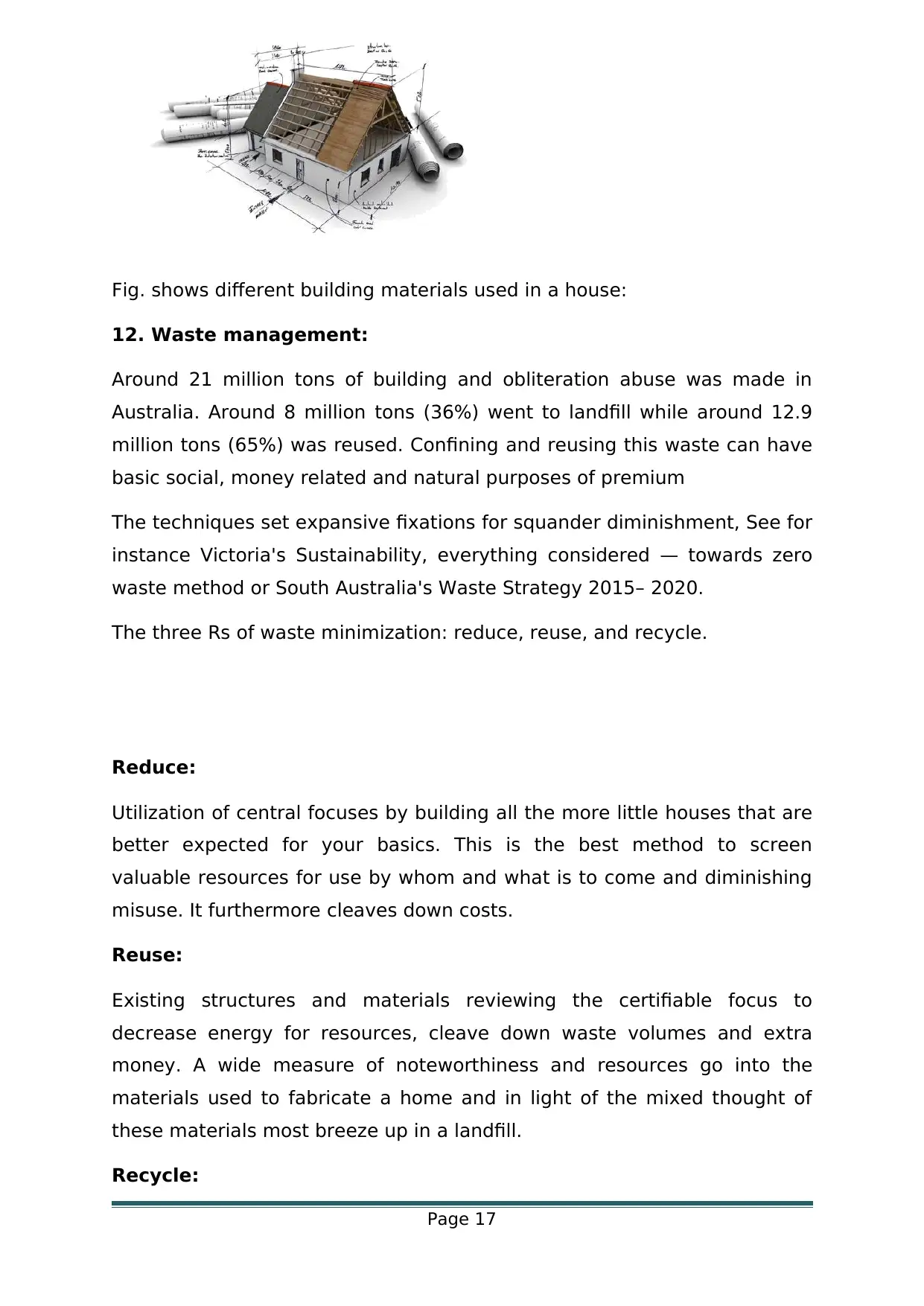
Fig. shows different building materials used in a house:
12. Waste management:
Around 21 million tons of building and obliteration abuse was made in
Australia. Around 8 million tons (36%) went to landfill while around 12.9
million tons (65%) was reused. Confining and reusing this waste can have
basic social, money related and natural purposes of premium
The techniques set expansive fixations for squander diminishment, See for
instance Victoria's Sustainability, everything considered — towards zero
waste method or South Australia's Waste Strategy 2015– 2020.
The three Rs of waste minimization: reduce, reuse, and recycle.
Reduce:
Utilization of central focuses by building all the more little houses that are
better expected for your basics. This is the best method to screen
valuable resources for use by whom and what is to come and diminishing
misuse. It furthermore cleaves down costs.
Reuse:
Existing structures and materials reviewing the certifiable focus to
decrease energy for resources, cleave down waste volumes and extra
money. A wide measure of noteworthiness and resources go into the
materials used to fabricate a home and in light of the mixed thought of
these materials most breeze up in a landfill.
Recycle:
Page 17
12. Waste management:
Around 21 million tons of building and obliteration abuse was made in
Australia. Around 8 million tons (36%) went to landfill while around 12.9
million tons (65%) was reused. Confining and reusing this waste can have
basic social, money related and natural purposes of premium
The techniques set expansive fixations for squander diminishment, See for
instance Victoria's Sustainability, everything considered — towards zero
waste method or South Australia's Waste Strategy 2015– 2020.
The three Rs of waste minimization: reduce, reuse, and recycle.
Reduce:
Utilization of central focuses by building all the more little houses that are
better expected for your basics. This is the best method to screen
valuable resources for use by whom and what is to come and diminishing
misuse. It furthermore cleaves down costs.
Reuse:
Existing structures and materials reviewing the certifiable focus to
decrease energy for resources, cleave down waste volumes and extra
money. A wide measure of noteworthiness and resources go into the
materials used to fabricate a home and in light of the mixed thought of
these materials most breeze up in a landfill.
Recycle:
Page 17
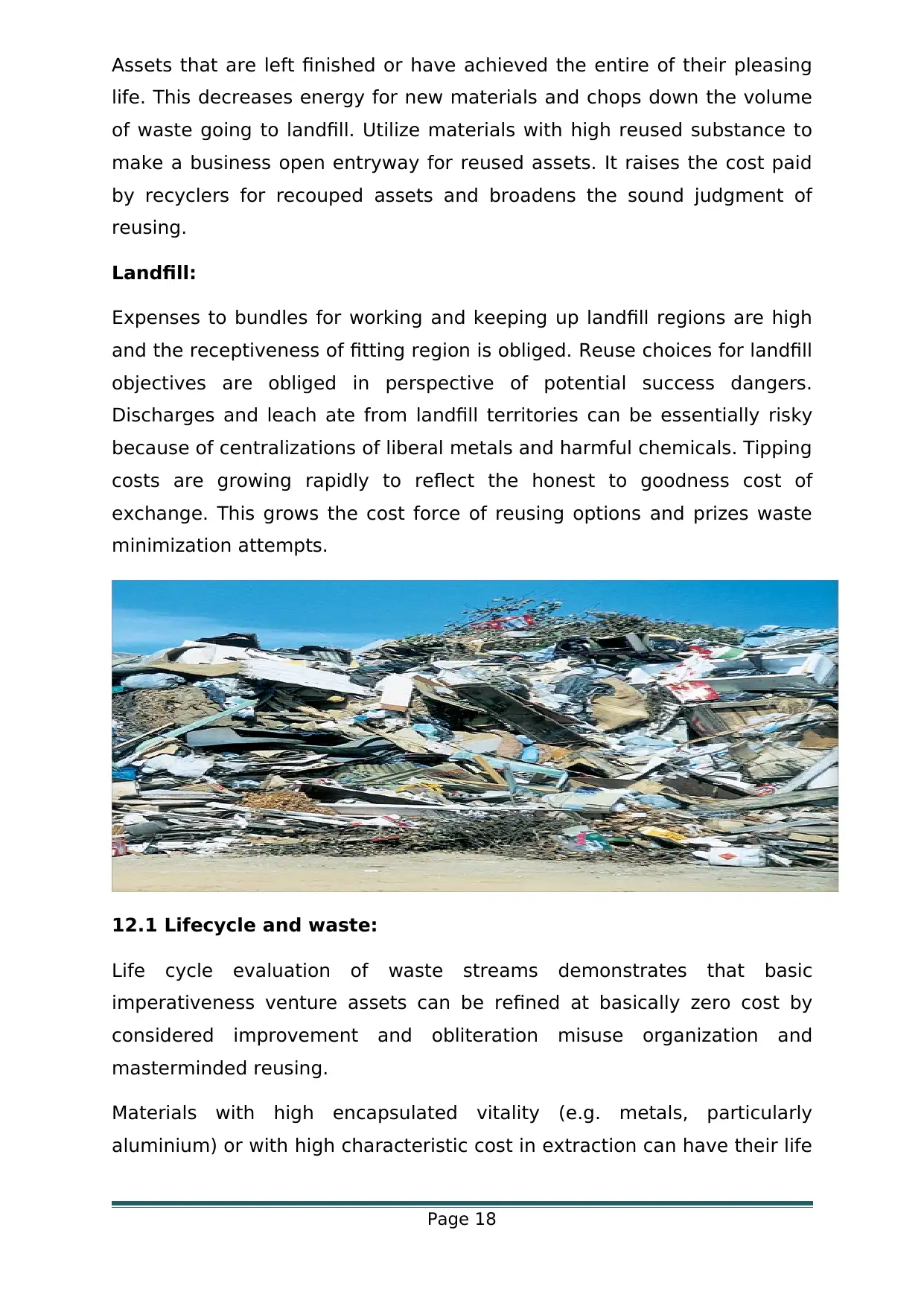
Assets that are left finished or have achieved the entire of their pleasing
life. This decreases energy for new materials and chops down the volume
of waste going to landfill. Utilize materials with high reused substance to
make a business open entryway for reused assets. It raises the cost paid
by recyclers for recouped assets and broadens the sound judgment of
reusing.
Landfill:
Expenses to bundles for working and keeping up landfill regions are high
and the receptiveness of fitting region is obliged. Reuse choices for landfill
objectives are obliged in perspective of potential success dangers.
Discharges and leach ate from landfill territories can be essentially risky
because of centralizations of liberal metals and harmful chemicals. Tipping
costs are growing rapidly to reflect the honest to goodness cost of
exchange. This grows the cost force of reusing options and prizes waste
minimization attempts.
12.1 Lifecycle and waste:
Life cycle evaluation of waste streams demonstrates that basic
imperativeness venture assets can be refined at basically zero cost by
considered improvement and obliteration misuse organization and
masterminded reusing.
Materials with high encapsulated vitality (e.g. metals, particularly
aluminium) or with high characteristic cost in extraction can have their life
Page 18
life. This decreases energy for new materials and chops down the volume
of waste going to landfill. Utilize materials with high reused substance to
make a business open entryway for reused assets. It raises the cost paid
by recyclers for recouped assets and broadens the sound judgment of
reusing.
Landfill:
Expenses to bundles for working and keeping up landfill regions are high
and the receptiveness of fitting region is obliged. Reuse choices for landfill
objectives are obliged in perspective of potential success dangers.
Discharges and leach ate from landfill territories can be essentially risky
because of centralizations of liberal metals and harmful chemicals. Tipping
costs are growing rapidly to reflect the honest to goodness cost of
exchange. This grows the cost force of reusing options and prizes waste
minimization attempts.
12.1 Lifecycle and waste:
Life cycle evaluation of waste streams demonstrates that basic
imperativeness venture assets can be refined at basically zero cost by
considered improvement and obliteration misuse organization and
masterminded reusing.
Materials with high encapsulated vitality (e.g. metals, particularly
aluminium) or with high characteristic cost in extraction can have their life
Page 18
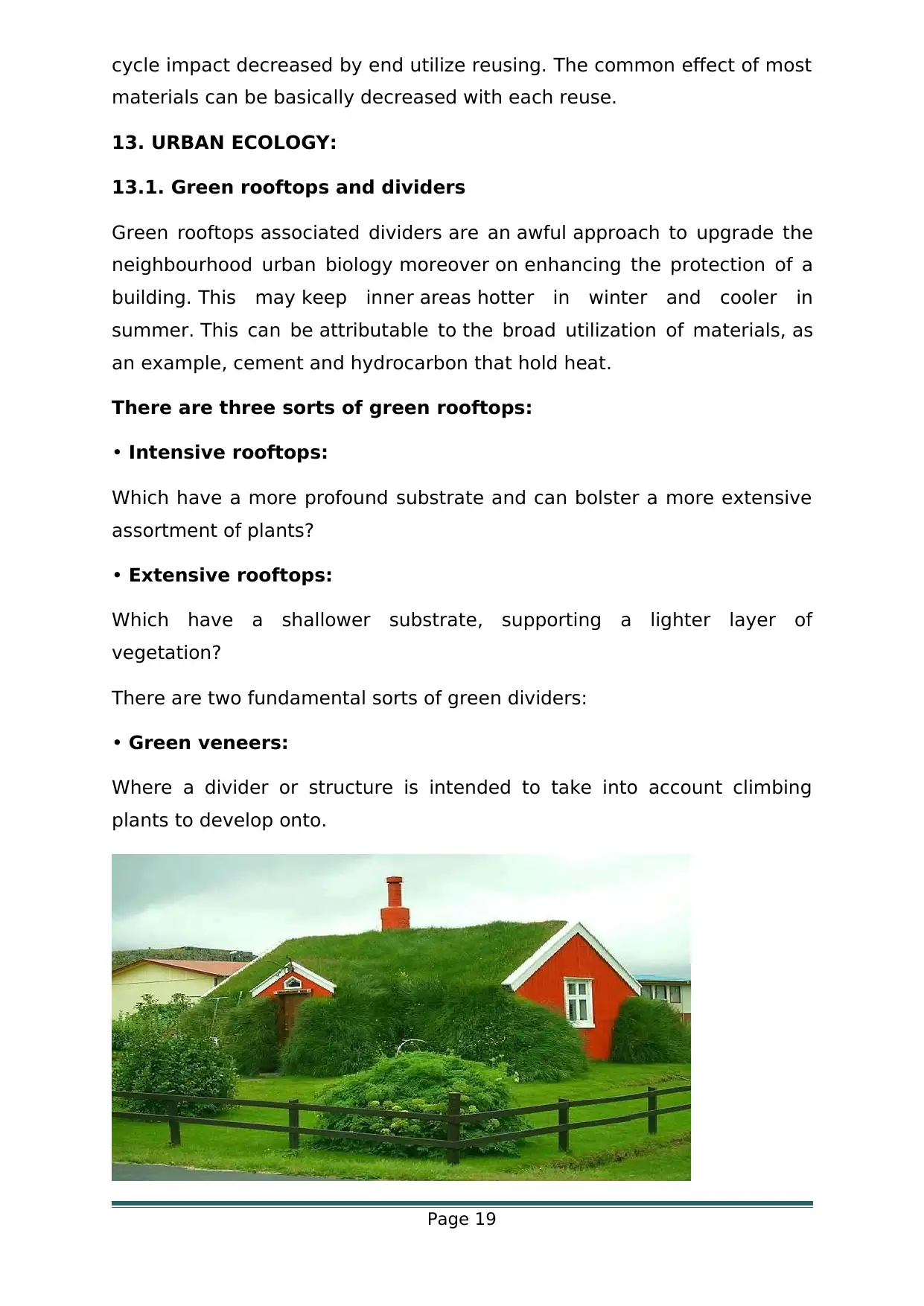
cycle impact decreased by end utilize reusing. The common effect of most
materials can be basically decreased with each reuse.
13. URBAN ECOLOGY:
13.1. Green rooftops and dividers
Green rooftops associated dividers are an awful approach to upgrade the
neighbourhood urban biology moreover on enhancing the protection of a
building. This may keep inner areas hotter in winter and cooler in
summer. This can be attributable to the broad utilization of materials, as
an example, cement and hydrocarbon that hold heat.
There are three sorts of green rooftops:
• Intensive rooftops:
Which have a more profound substrate and can bolster a more extensive
assortment of plants?
• Extensive rooftops:
Which have a shallower substrate, supporting a lighter layer of
vegetation?
There are two fundamental sorts of green dividers:
• Green veneers:
Where a divider or structure is intended to take into account climbing
plants to develop onto.
Page 19
materials can be basically decreased with each reuse.
13. URBAN ECOLOGY:
13.1. Green rooftops and dividers
Green rooftops associated dividers are an awful approach to upgrade the
neighbourhood urban biology moreover on enhancing the protection of a
building. This may keep inner areas hotter in winter and cooler in
summer. This can be attributable to the broad utilization of materials, as
an example, cement and hydrocarbon that hold heat.
There are three sorts of green rooftops:
• Intensive rooftops:
Which have a more profound substrate and can bolster a more extensive
assortment of plants?
• Extensive rooftops:
Which have a shallower substrate, supporting a lighter layer of
vegetation?
There are two fundamental sorts of green dividers:
• Green veneers:
Where a divider or structure is intended to take into account climbing
plants to develop onto.
Page 19
Paraphrase This Document
Need a fresh take? Get an instant paraphrase of this document with our AI Paraphraser
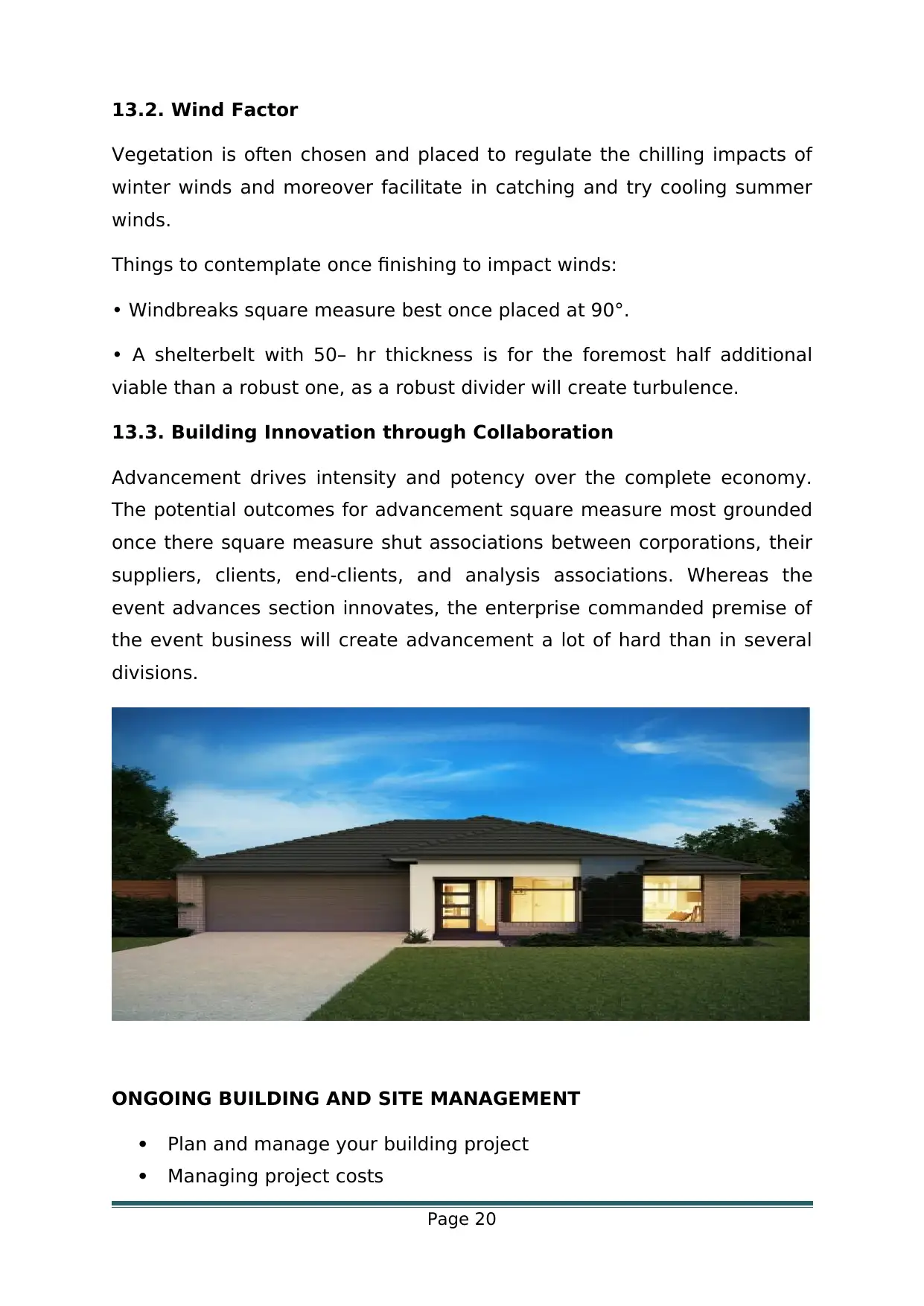
13.2. Wind Factor
Vegetation is often chosen and placed to regulate the chilling impacts of
winter winds and moreover facilitate in catching and try cooling summer
winds.
Things to contemplate once finishing to impact winds:
• Windbreaks square measure best once placed at 90°.
• A shelterbelt with 50– hr thickness is for the foremost half additional
viable than a robust one, as a robust divider will create turbulence.
13.3. Building Innovation through Collaboration
Advancement drives intensity and potency over the complete economy.
The potential outcomes for advancement square measure most grounded
once there square measure shut associations between corporations, their
suppliers, clients, end-clients, and analysis associations. Whereas the
event advances section innovates, the enterprise commanded premise of
the event business will create advancement a lot of hard than in several
divisions.
ONGOING BUILDING AND SITE MANAGEMENT
Plan and manage your building project
Managing project costs
Page 20
Vegetation is often chosen and placed to regulate the chilling impacts of
winter winds and moreover facilitate in catching and try cooling summer
winds.
Things to contemplate once finishing to impact winds:
• Windbreaks square measure best once placed at 90°.
• A shelterbelt with 50– hr thickness is for the foremost half additional
viable than a robust one, as a robust divider will create turbulence.
13.3. Building Innovation through Collaboration
Advancement drives intensity and potency over the complete economy.
The potential outcomes for advancement square measure most grounded
once there square measure shut associations between corporations, their
suppliers, clients, end-clients, and analysis associations. Whereas the
event advances section innovates, the enterprise commanded premise of
the event business will create advancement a lot of hard than in several
divisions.
ONGOING BUILDING AND SITE MANAGEMENT
Plan and manage your building project
Managing project costs
Page 20
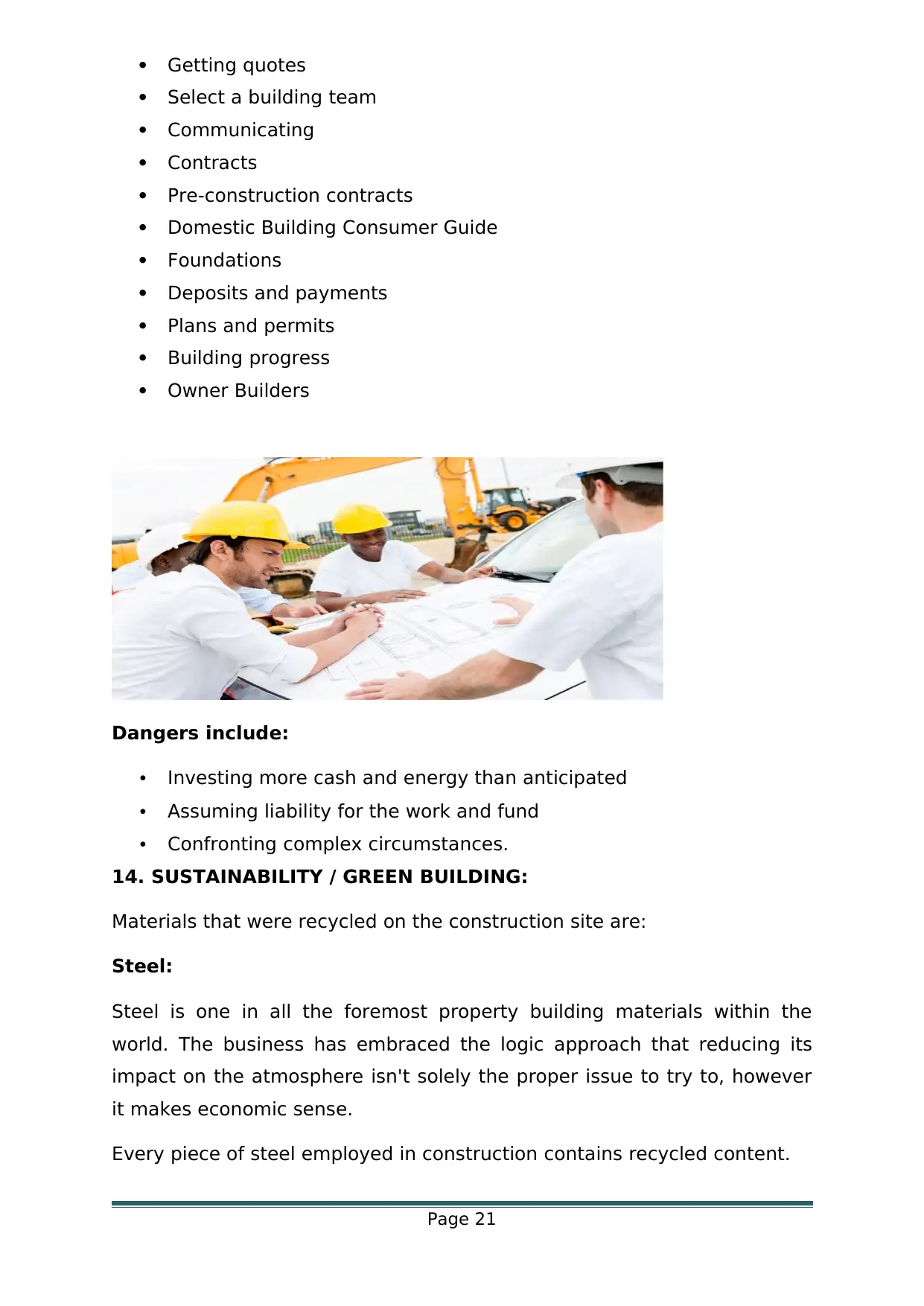
Getting quotes
Select a building team
Communicating
Contracts
Pre-construction contracts
Domestic Building Consumer Guide
Foundations
Deposits and payments
Plans and permits
Building progress
Owner Builders
Dangers include:
• Investing more cash and energy than anticipated
• Assuming liability for the work and fund
• Confronting complex circumstances.
14. SUSTAINABILITY / GREEN BUILDING:
Materials that were recycled on the construction site are:
Steel:
Steel is one in all the foremost property building materials within the
world. The business has embraced the logic approach that reducing its
impact on the atmosphere isn't solely the proper issue to try to, however
it makes economic sense.
Every piece of steel employed in construction contains recycled content.
Page 21
Select a building team
Communicating
Contracts
Pre-construction contracts
Domestic Building Consumer Guide
Foundations
Deposits and payments
Plans and permits
Building progress
Owner Builders
Dangers include:
• Investing more cash and energy than anticipated
• Assuming liability for the work and fund
• Confronting complex circumstances.
14. SUSTAINABILITY / GREEN BUILDING:
Materials that were recycled on the construction site are:
Steel:
Steel is one in all the foremost property building materials within the
world. The business has embraced the logic approach that reducing its
impact on the atmosphere isn't solely the proper issue to try to, however
it makes economic sense.
Every piece of steel employed in construction contains recycled content.
Page 21
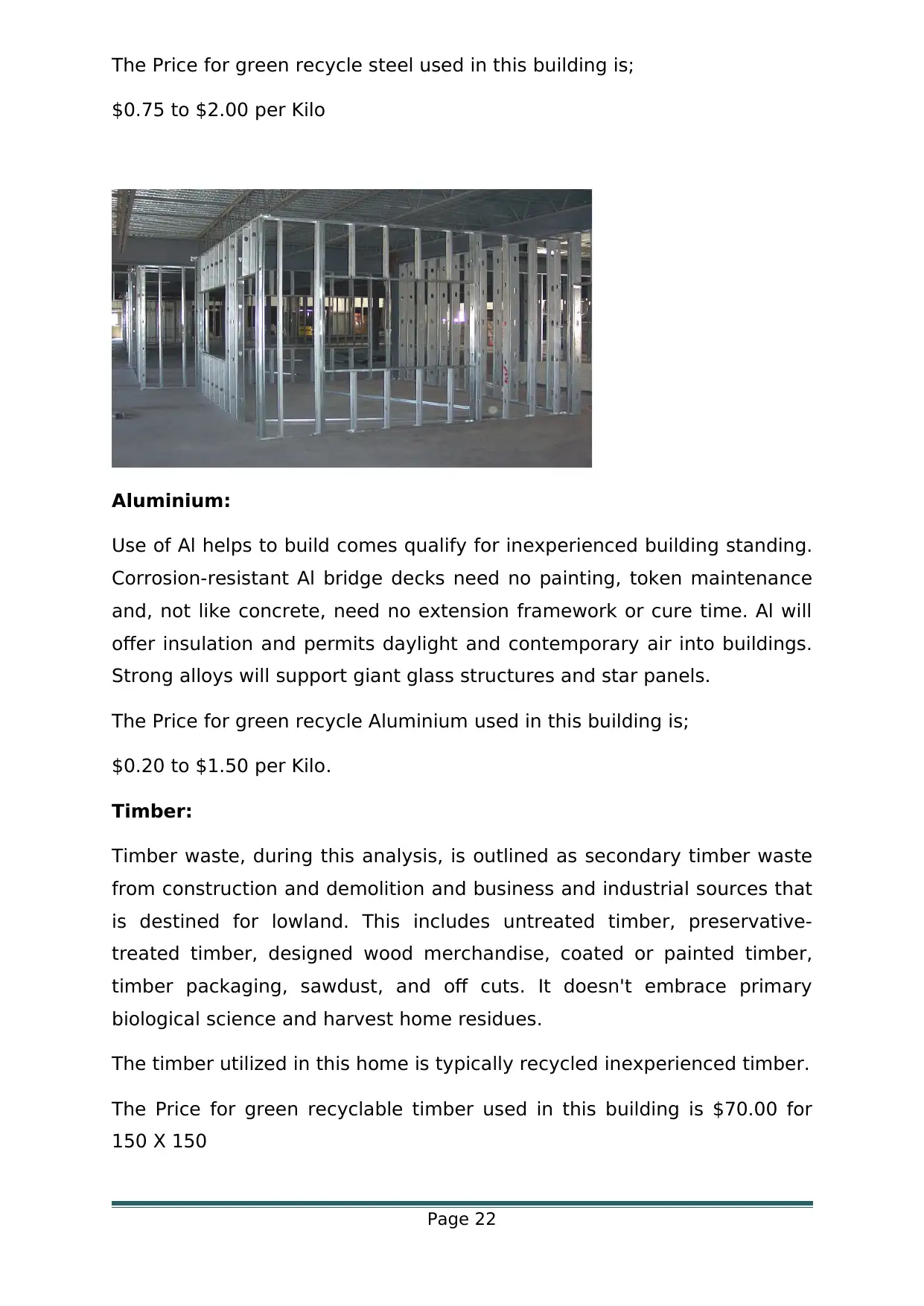
The Price for green recycle steel used in this building is;
$0.75 to $2.00 per Kilo
Aluminium:
Use of Al helps to build comes qualify for inexperienced building standing.
Corrosion-resistant Al bridge decks need no painting, token maintenance
and, not like concrete, need no extension framework or cure time. Al will
offer insulation and permits daylight and contemporary air into buildings.
Strong alloys will support giant glass structures and star panels.
The Price for green recycle Aluminium used in this building is;
$0.20 to $1.50 per Kilo.
Timber:
Timber waste, during this analysis, is outlined as secondary timber waste
from construction and demolition and business and industrial sources that
is destined for lowland. This includes untreated timber, preservative-
treated timber, designed wood merchandise, coated or painted timber,
timber packaging, sawdust, and off cuts. It doesn't embrace primary
biological science and harvest home residues.
The timber utilized in this home is typically recycled inexperienced timber.
The Price for green recyclable timber used in this building is $70.00 for
150 X 150
Page 22
$0.75 to $2.00 per Kilo
Aluminium:
Use of Al helps to build comes qualify for inexperienced building standing.
Corrosion-resistant Al bridge decks need no painting, token maintenance
and, not like concrete, need no extension framework or cure time. Al will
offer insulation and permits daylight and contemporary air into buildings.
Strong alloys will support giant glass structures and star panels.
The Price for green recycle Aluminium used in this building is;
$0.20 to $1.50 per Kilo.
Timber:
Timber waste, during this analysis, is outlined as secondary timber waste
from construction and demolition and business and industrial sources that
is destined for lowland. This includes untreated timber, preservative-
treated timber, designed wood merchandise, coated or painted timber,
timber packaging, sawdust, and off cuts. It doesn't embrace primary
biological science and harvest home residues.
The timber utilized in this home is typically recycled inexperienced timber.
The Price for green recyclable timber used in this building is $70.00 for
150 X 150
Page 22
Secure Best Marks with AI Grader
Need help grading? Try our AI Grader for instant feedback on your assignments.
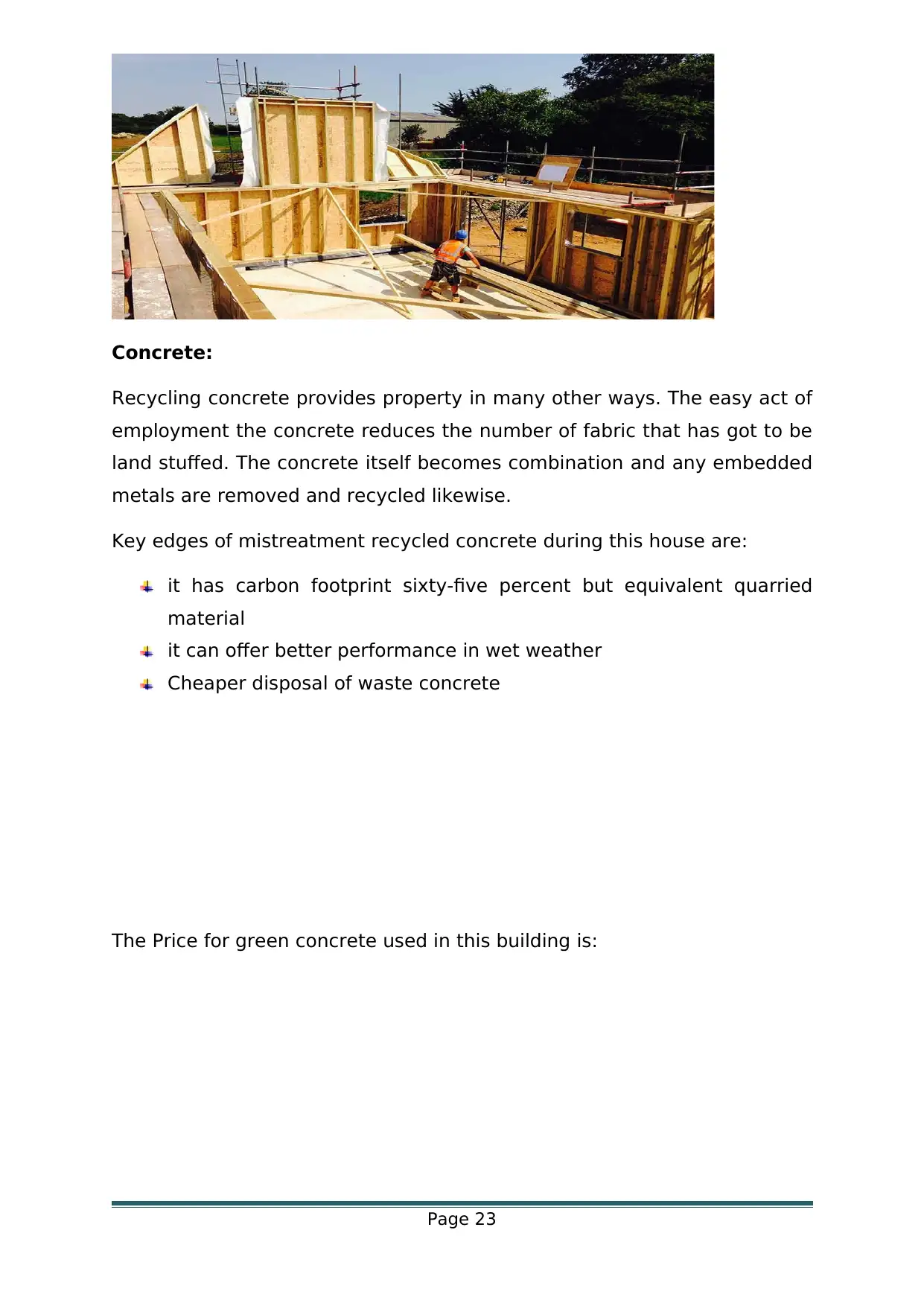
Concrete:
Recycling concrete provides property in many other ways. The easy act of
employment the concrete reduces the number of fabric that has got to be
land stuffed. The concrete itself becomes combination and any embedded
metals are removed and recycled likewise.
Key edges of mistreatment recycled concrete during this house are:
it has carbon footprint sixty-five percent but equivalent quarried
material
it can offer better performance in wet weather
Cheaper disposal of waste concrete
The Price for green concrete used in this building is:
Page 23
Recycling concrete provides property in many other ways. The easy act of
employment the concrete reduces the number of fabric that has got to be
land stuffed. The concrete itself becomes combination and any embedded
metals are removed and recycled likewise.
Key edges of mistreatment recycled concrete during this house are:
it has carbon footprint sixty-five percent but equivalent quarried
material
it can offer better performance in wet weather
Cheaper disposal of waste concrete
The Price for green concrete used in this building is:
Page 23
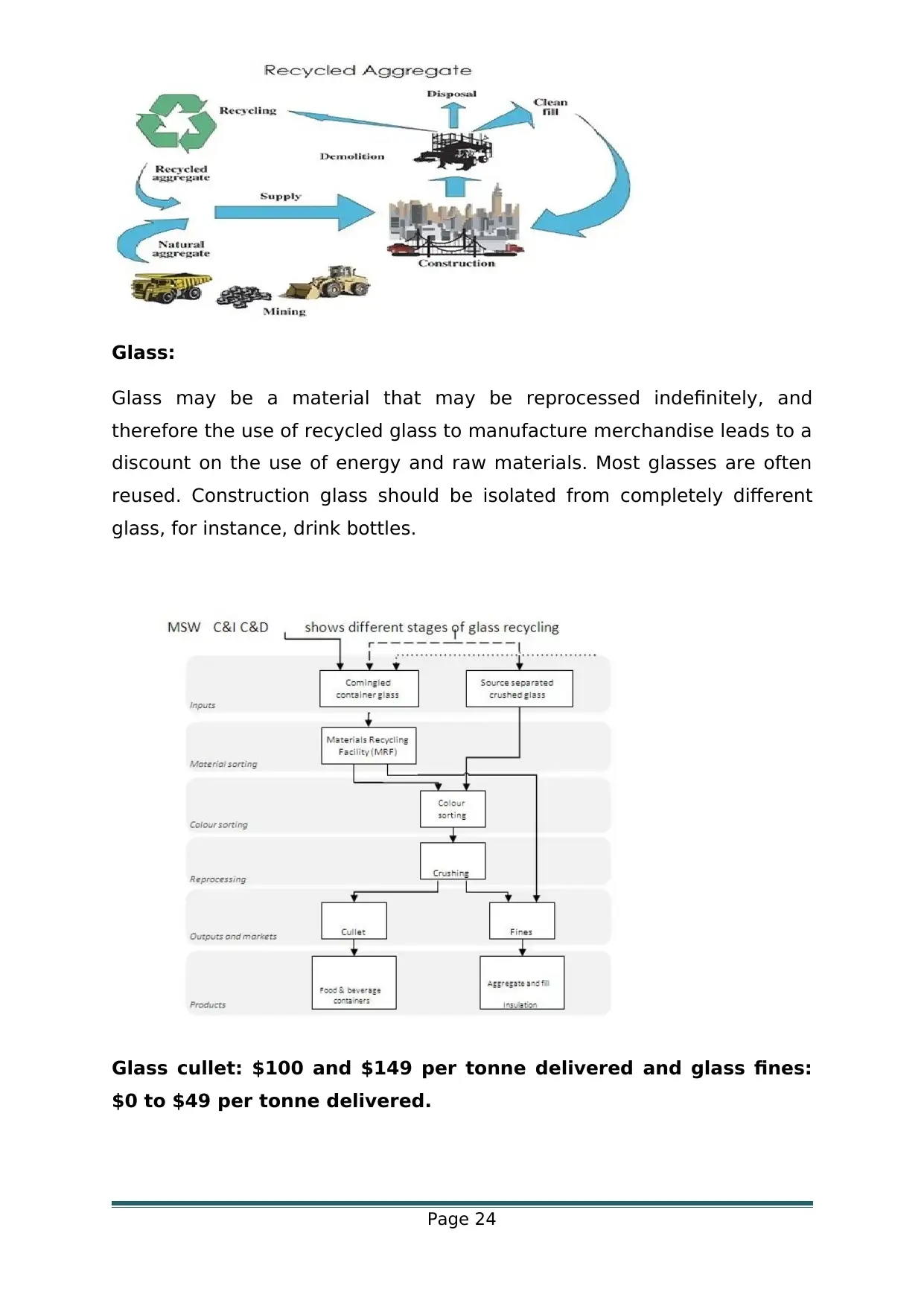
Glass:
Glass may be a material that may be reprocessed indefinitely, and
therefore the use of recycled glass to manufacture merchandise leads to a
discount on the use of energy and raw materials. Most glasses are often
reused. Construction glass should be isolated from completely different
glass, for instance, drink bottles.
Glass cullet: $100 and $149 per tonne delivered and glass fines:
$0 to $49 per tonne delivered.
Page 24
Glass may be a material that may be reprocessed indefinitely, and
therefore the use of recycled glass to manufacture merchandise leads to a
discount on the use of energy and raw materials. Most glasses are often
reused. Construction glass should be isolated from completely different
glass, for instance, drink bottles.
Glass cullet: $100 and $149 per tonne delivered and glass fines:
$0 to $49 per tonne delivered.
Page 24
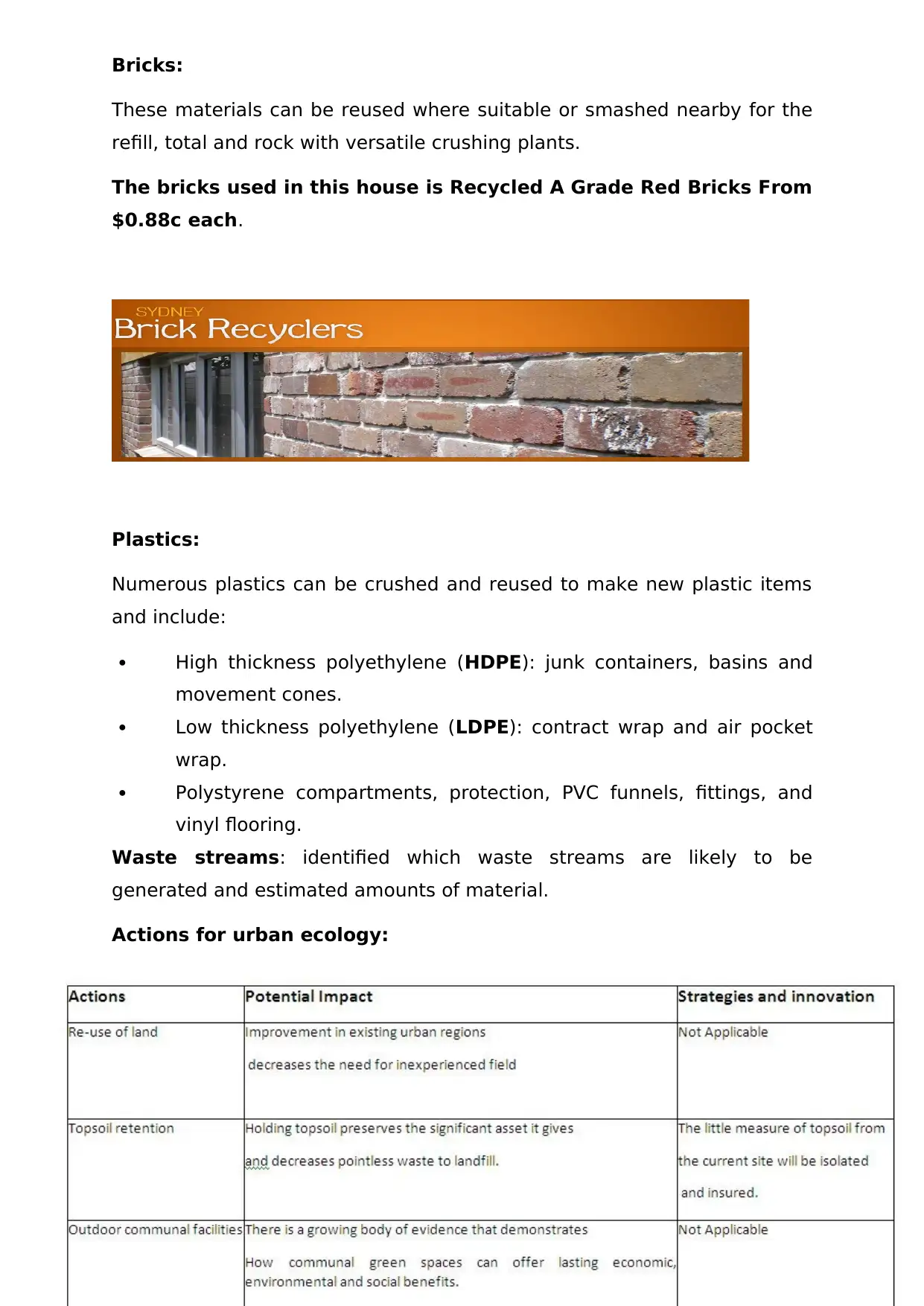
Bricks:
These materials can be reused where suitable or smashed nearby for the
refill, total and rock with versatile crushing plants.
The bricks used in this house is Recycled A Grade Red Bricks From
$0.88c each.
Plastics:
Numerous plastics can be crushed and reused to make new plastic items
and include:
High thickness polyethylene (HDPE): junk containers, basins and
movement cones.
Low thickness polyethylene (LDPE): contract wrap and air pocket
wrap.
Polystyrene compartments, protection, PVC funnels, fittings, and
vinyl flooring.
Waste streams: identified which waste streams are likely to be
generated and estimated amounts of material.
Actions for urban ecology:
Page 25
These materials can be reused where suitable or smashed nearby for the
refill, total and rock with versatile crushing plants.
The bricks used in this house is Recycled A Grade Red Bricks From
$0.88c each.
Plastics:
Numerous plastics can be crushed and reused to make new plastic items
and include:
High thickness polyethylene (HDPE): junk containers, basins and
movement cones.
Low thickness polyethylene (LDPE): contract wrap and air pocket
wrap.
Polystyrene compartments, protection, PVC funnels, fittings, and
vinyl flooring.
Waste streams: identified which waste streams are likely to be
generated and estimated amounts of material.
Actions for urban ecology:
Page 25
Paraphrase This Document
Need a fresh take? Get an instant paraphrase of this document with our AI Paraphraser
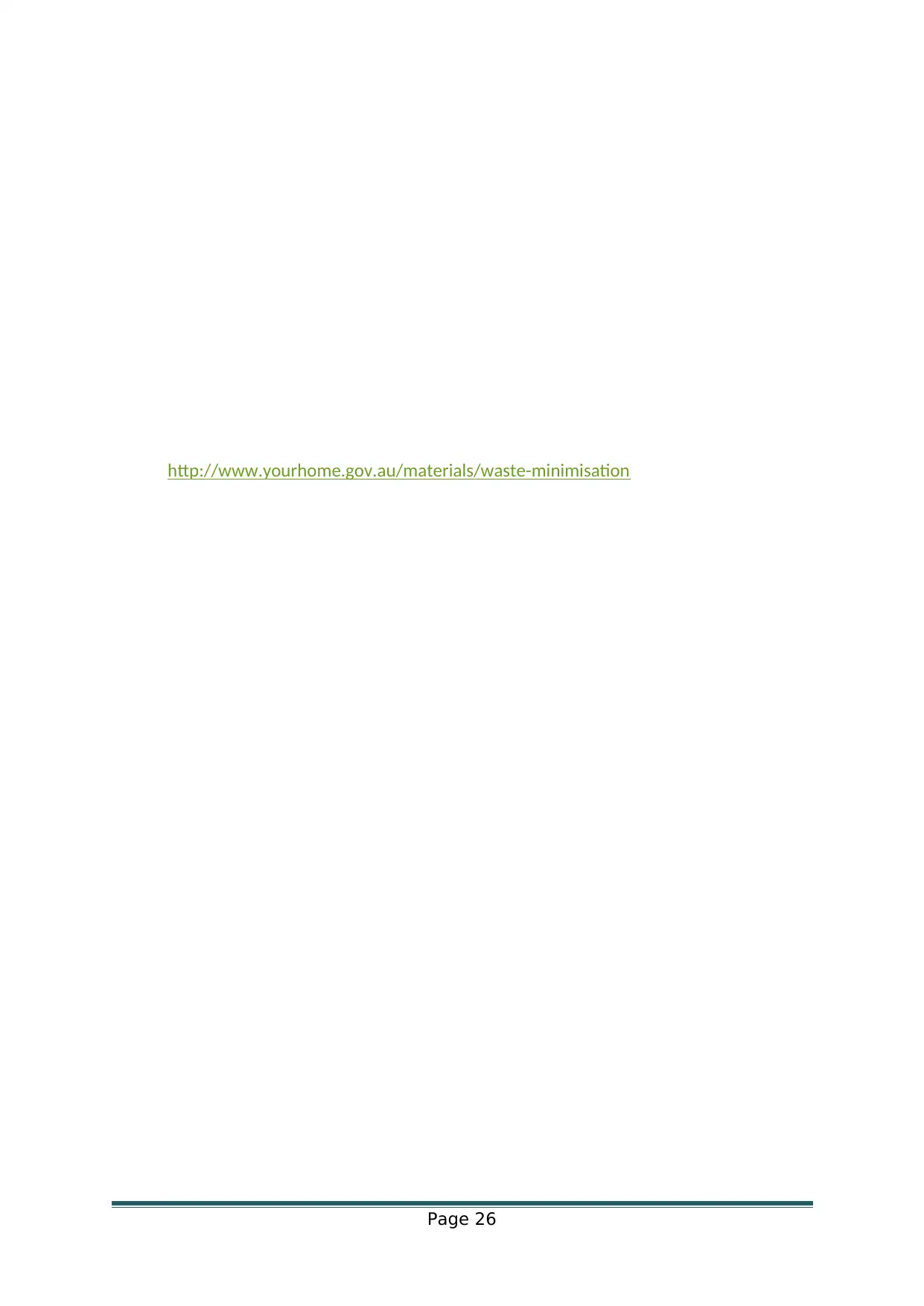
http://www.yourhome.gov.au/materials/waste-minimisation
Page 26
Page 26
1 out of 26
Related Documents
Your All-in-One AI-Powered Toolkit for Academic Success.
+13062052269
info@desklib.com
Available 24*7 on WhatsApp / Email
![[object Object]](/_next/static/media/star-bottom.7253800d.svg)
Unlock your academic potential
© 2024 | Zucol Services PVT LTD | All rights reserved.





